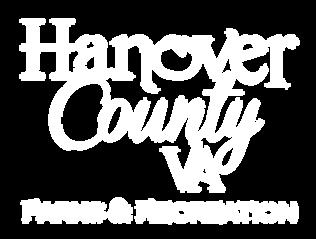
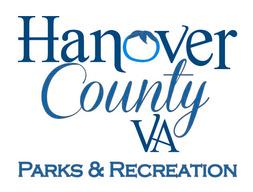
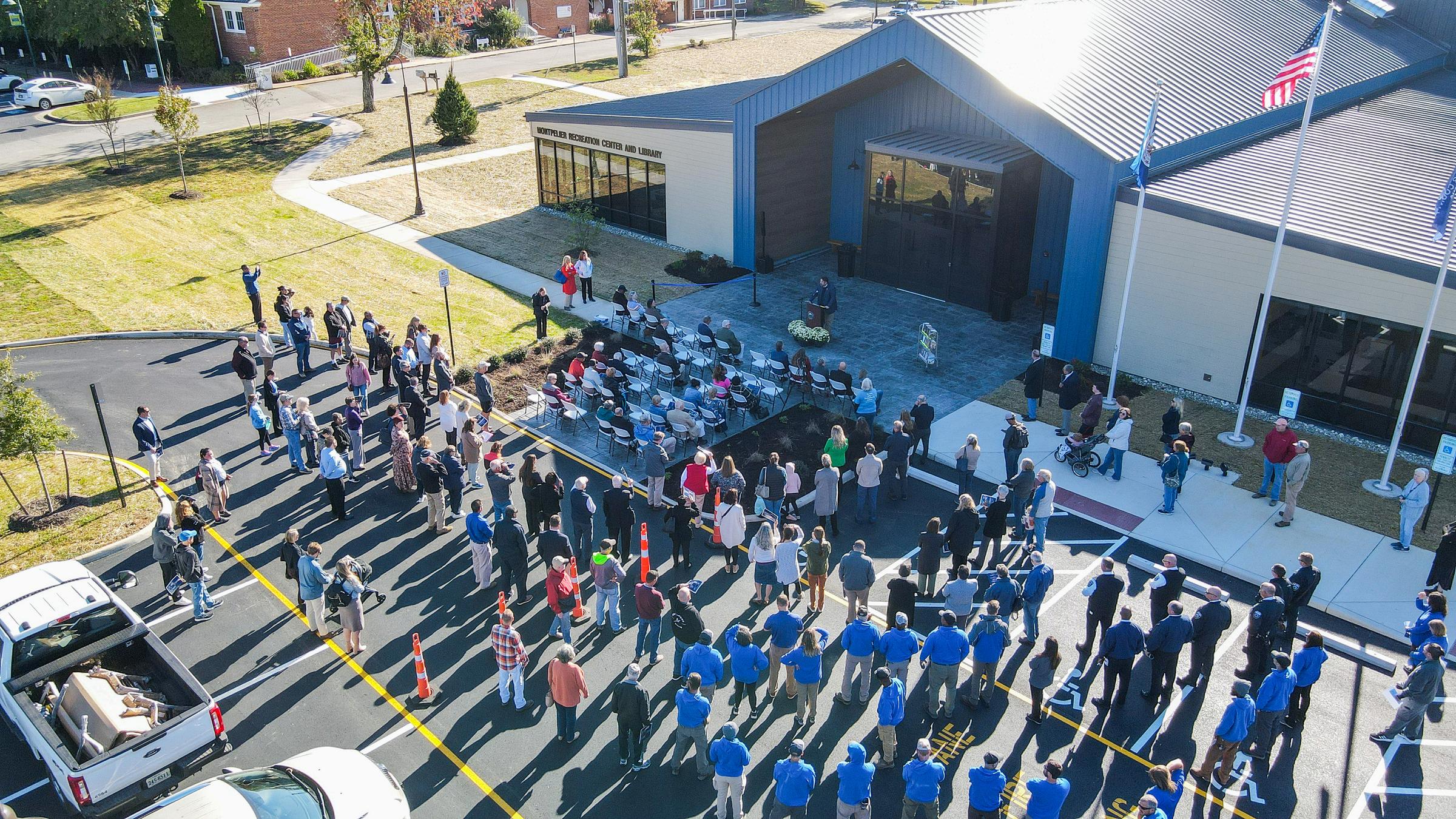








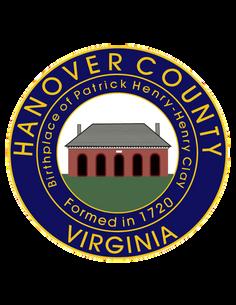
The 2035 Parks and Recreation Master Plan is made possible by the commitment to improve quality of life for all residents through parks and recreation opportunities with support of the Hanover County Board of Supervisors, the Hanover County Parks and Recreation Advisory Commission, the Hanover County Planning Commission, Hanover County Administration, and the dedicated staff of the Parks and Recreation Department
F Michael Herzberg, IV - Chair
Sean M Davis - Vice Chair
Faye O Prichard
Jeff S Stoneman
Danielle Grieshaber Floyd
Ryan M Hudson
Susan P Dibble
Cold Harbor District
Henry District
Ashland District
Beaverdam District
Chickahominy District
Mechanicsville District
South Anna District
Jim Hunt
Rachel Levy
Roger Braxton
Michael Morris
Kimberly Carswell
Randy Mudd
Tricia McClintock
Elton Wade, III
Manny Tavares
Mary Waddy
Paul Heizer
Brent Sprouse
Chris Cullen
Jordan Padgett
Greg Coleman
Amanda Washington
Ashland District
Ashland District
Beaverdam District
Beaverdam District
Chickahominy District
Chickahominy District
Cold Harbor District
Cold Harbor District
Henry District
Henry District
Mechanicsville District
Mechanicsville District
South Anna District
South Anna District
Hanover County School Board
Hanover County Public Schools
County Leadership and Department Staff
John Budesky
Bret Schardein
Aaron Reidmiller, CPRE
Marcy Durrer
Patti McGrath
Janit Llewellyn
Andrew Pompei
Bill Richter
Cecilia O’Neill
County Administrator
Deputy County Administrator
Director of Parks and Recreation
Deputy Director - Recreation Services
Deputy Director - Park Services
Principal, Park Planning and Sustainability
Deputy Director of Planning and Community Development
IT Systems Engineer - GIS Team Lead
IT Systems Engineer - GIS
Cover: Pole Green Park Playground 2025
Dear Hanover County Residents, Partners, and Stakeholders,

It is my great pleasure to present the 2035 Hanover County Parks and Recreation Master Plan, a comprehensive roadmap that reflects our shared vision for the future of parks, recreation, and community well-being across the County This plan is the result of more than a year of research, assessment, collaboration, and most importantly listening to you, the residents of Hanover County
Our department has long been committed to enhancing the quality of life for everyone who calls Hanover home This Master Plan builds upon that commitment by identifying the most pressing needs and most promising opportunities for growth and improvement From expanding access to parks and trails, to modernizing aging facilities, to fostering stronger partnerships with schools, civic groups, and nonprofits, this plan provides a clear and actionable strategy for the next ten years It also aligns closely with the goals set forth in Envision Hanover, the County’s Comprehensive Plan, ensuring a consistent and coordinated vision for our future
I want to thank the many individuals, organizations, and community members who shared their voices throughout this process Your feedback whether through surveys, public meetings, or direct conversations was essential in shaping this plan As we move forward, our success will continue to depend on collaboration and shared stewardship Together, we can build a parks and recreation system that reflects our County’s values, honors its unique character, and supports the health, happiness, and connection of every resident
Thank you for your continued support of Hanover County Parks and Recreation
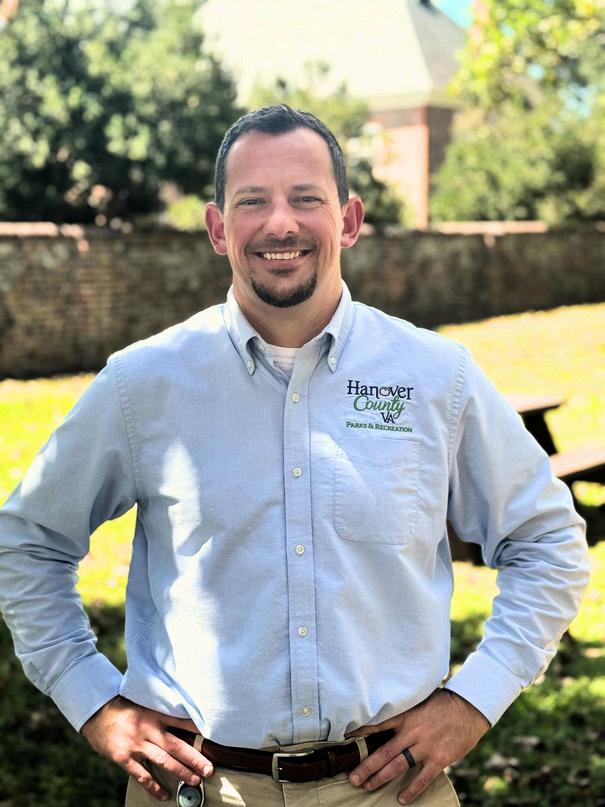
Sincerely,

Aaron Reidmiller, CPRE Director, Hanover County Parks and Recreation
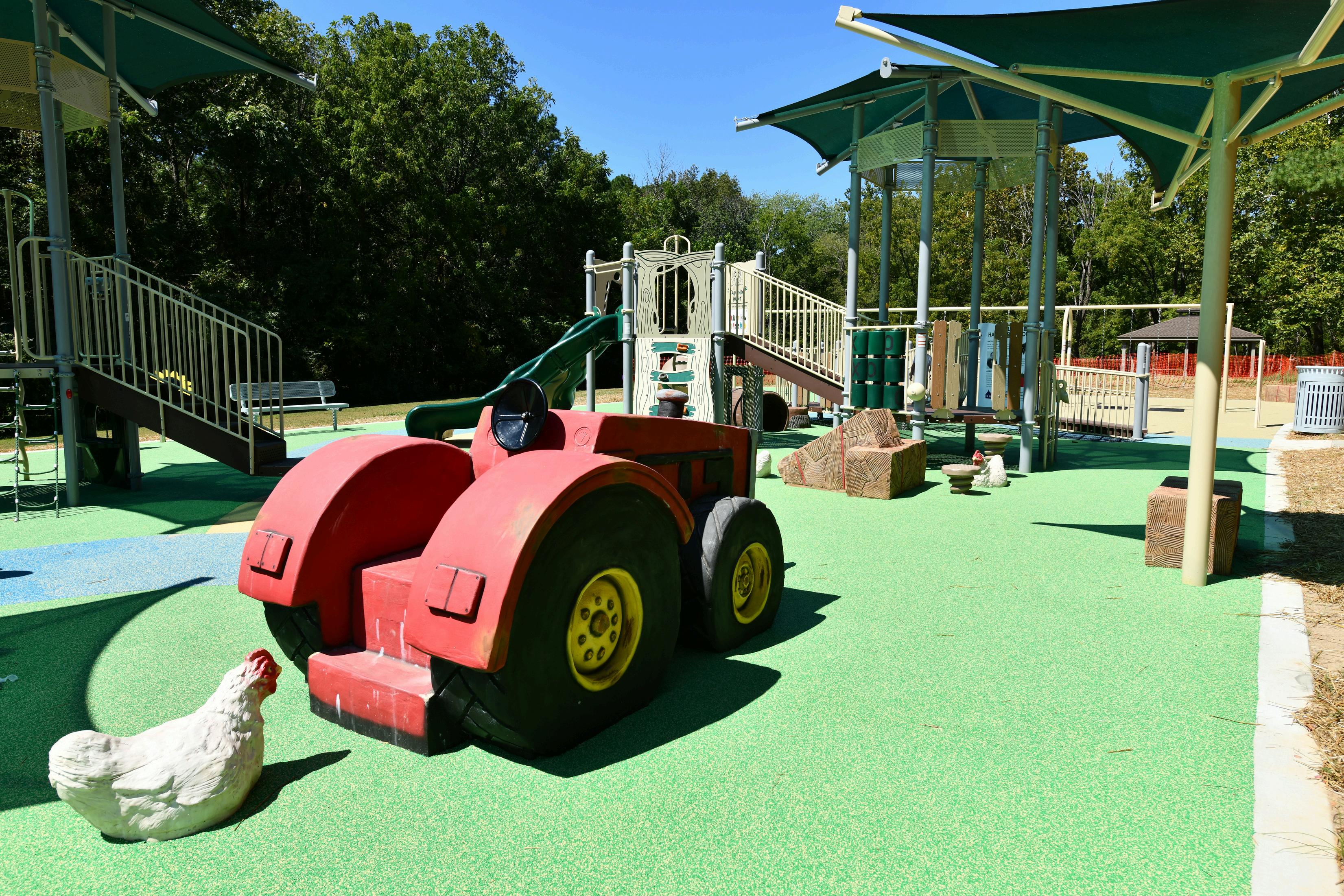








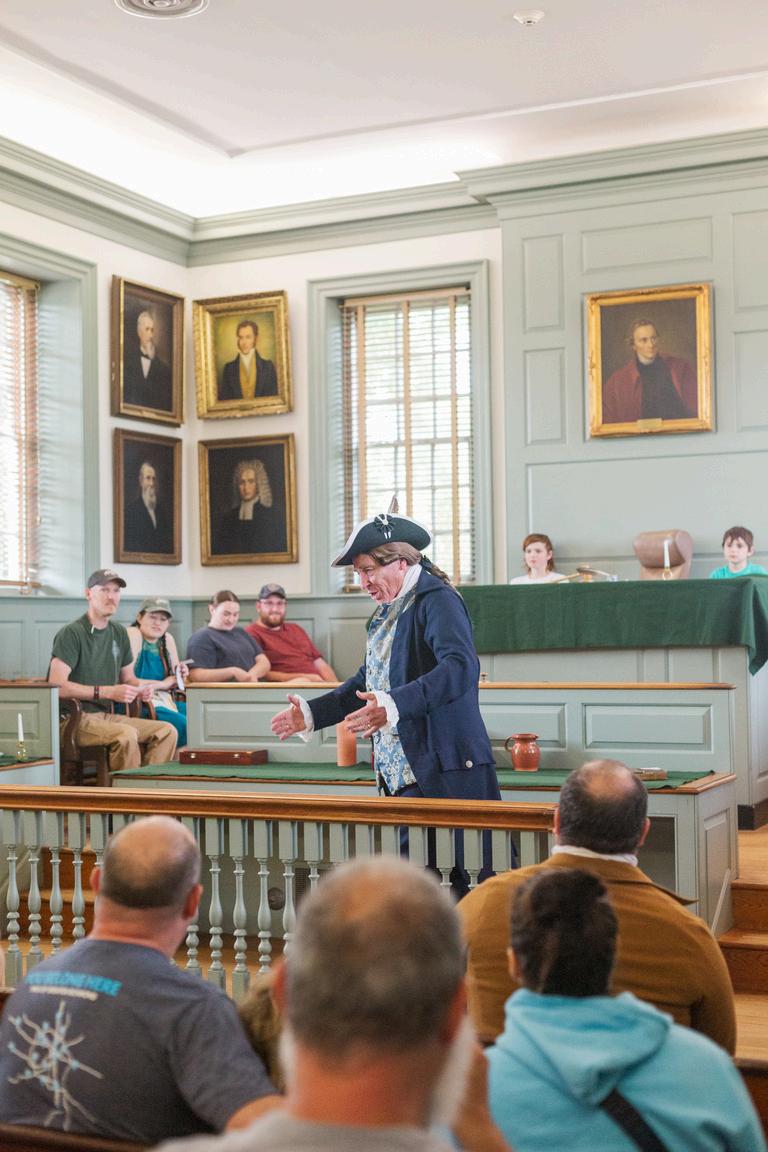
The mission of Hanover County Parks and Recreation is to create meaningful recreational experiences that enrich the community and foster overall well-being while providing high-quality, accessible parks and natural areas.
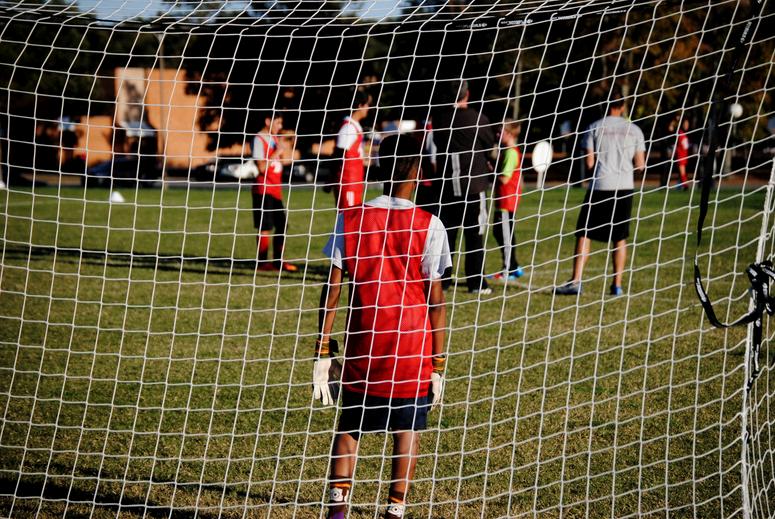



The Hanover County Parks and Recreation Master Plan serves as a comprehensive guide for the strategic development, enhancement, and stewardship of the County’s park system, recreational facilities, programs, and natural resources over the next decade With a growing population and evolving recreational trends, the plan is designed to ensure that Hanover County remains responsive to the current and future needs of its residents By aligning with the County’s Comprehensive Plan and regional priorities, the Master Plan provides a framework for informed decision-making that supports both quality of life and sustainable community growth.
At its core, the plan aims to expand equitable access to parks and recreation opportunities and improve the condition and functionality of existing facilities, while exploring opportunities for sports tourism, cultural preservation, and environmental stewardship. Expanding access includes addressing geographic gaps in service, ensuring facilities are accessible to residents of all ages and abilities, and reducing barriers related to cost, transportation, and awareness. Facility improvements emphasize modernization, safety, and adaptability, allowing spaces to accommodate a wide range of recreational needs and community events The plan also highlights the importance of protecting Hanover’s historic sites, cultural landscapes, and natural resources, recognizing their role in shaping community identity and providing unique educational and recreational experiences At the same time, growing interest in sports tourism presents an opportunity to attract regional visitors, generate economic benefits, and showcase Hanover’s recreational assets, all while balancing development with preservation and sustainability
Ultimately, the Master Plan seeks to foster a healthy, active, and connected community by providing spaces and programs that promote wellness, social interaction, and outdoor engagement. Through strong public-private partnerships, fiscally responsible investment strategies, and ongoing community involvement, the plan establishes a clear path for building a resilient and vibrant parks and recreation system. It is both a visionary document and an actionable strategy - guiding the County in meeting immediate needs while preparing for future challenges and opportunities.
A system-wide park master plan is a comprehensive document and process that includes an internal assessment, community engagement, resource and data collection, and development of an implementation plan
Internal Assessment is the foundation for the vision, mission, and plan This is the first step in understanding agency needs and identifying opportunities to collaborate with the community, special interest groups, the Parks and Recreation Advisory Committee, elected officials, and other relevant stakeholders to develop the plan
Community Engagement is integrated into all aspects of the master plan process to ensure the community is engaged through surveys, public meetings, and outreach. Community engagement supports data collection, analysis, and implementation to achieve more community-wide inclusion.
Resources and Data Collection involve qualitative and quantitative analysis to identify gaps in park distribution, quality, safety, programming opportunities, and inclusion.
Master Plan Adoption involves presenting the plan to the Parks and Recreation Advisory Commission, the Hanover County Planning Commission and the Hanover County Board of Supervisors for final adoption
Implementation includes an action plan and mapping of the future conditions needed to meet parks and recreation needs
Each of these steps is integral to developing a well-rounded plan that takes into account current resources and gaps in service delivery. The staff of Hanover County Parks and Recreation have worked diligently to facilitate each step of the development process.
The Hanover County Parks and Recreation Master Plan has been developed in alignment with the County’s 2023 Comprehensive Plan - Envision Hanover. The Comprehensive Plan is a long-term guide for growth and development, establishing a vision of what Hanover County could look like in 2045 The plan addresses a variety of topics, including land use, housing, economic development, and natural resources In the 2023 plan, significant focus is placed on active living, community facilities, history & culture, and environment & resiliency - all of which are intertwined with goals of the Parks and Recreation Master Plan

The Comprehensive Plan was developed based upon feedback provided by a variety of stakeholders, including residents, businesses, landowners, and other community members. Per the Code of Virginia, every locality must have a Comprehensive Plan, and it must be reviewed at least once every five years. The purpose of the Comprehensive Plan is not to regulate, but rather guide land use, transportation, and infrastructure decisions.
The Comprehensive Plan states that parks are essential to the County’s quality of life by providing active and passive recreational activities and offering gathering places that foster a sense of community Parks also help preserve environmental features such as open space, wildlife habitat, and cultural resources, affording the population a greater opportunity to appreciate them During the public engagement period of Envision Hanover, many residents demonstrated significant interest in having more parks and recreation opportunities, particularly amenitized parks within the Suburban Service Area (SSA) Additionally, there is interest in having more athletic facilities in closer proximity to suburban neighborhoods, specifically the Mechanicsville and Atlee areas
Development of the Parks and Recreation Master Plan also takes into consideration and influences other planning tools used by the County.
Fall 2022
Initial community survey created to collect data used to shape plan development timeline and identify priority areas of focus
Summer/Fall 2023
Internal assessment of facilities, programming, staff, and department function; evaluation of overall resources and service delivery.
Summer/Fall 2024
Data analysis and field research; identification of national and statewide trends.
Spring 2023
Master Plan outline finalized and steps for development identified
Winter/Spring 2024
Community engagement meetings held in all seven magisterial districts; online survey offered for additional community input
Spring/Summer 2025
Plan content finalized and formatting/graphic design initiated
Early Fall 2025
Initial review of plan conducted with key stakeholders; final public feedback collected.
Winter 2025
Final review and adoption of plan by Parks and Recreation Advisory Commission, Planning Commission, and Hanover County Board of Supervisors
The following key findings summarize the most important insights gathered through the planning process, including community engagement, facility assessments, demographic analysis, and benchmarking against national and regional standards. These findings highlight the current strengths of Hanover County’s parks and recreation system, as well as the critical gaps and opportunities that will shape future priorities and investment over the next decade.
Close service gaps by strategically acquiring land and developing neighborhood parks, expanding trail systems, and ensuring recreation opportunities are available across all magisterial districts
Reinvest in aging infrastructure through targeted upgrades to athletic fields, playgrounds, and restrooms while introducing modern amenities such as inclusive play features, splash pads, and sustainable facility design Advance the development of the eastern Hanover recreation center and continue to explore innovative facility partnerships.
Build a responsive programming model informed by ongoing needs assessments. Establish clear cost recovery policies, maintain a balance between essential services and specialty programs, and strengthen offerings through partnerships with schools, nonprofits, and private providers.
Protect battlefields, historic schools, and cultural landscapes while embedding sustainable practices into facility operations Promote energy efficiency, green infrastructure, and conservation best practices to ensure that Hanover’s parks serve as models of environmental responsibility
Expand collaboration with Hanover County Public Schools, civic associations, sports leagues, and regional tourism entities. These partnerships will maximize facility use, reduce duplication, and position Hanover as a regional hub for sports tourism and recreation.
The Hanover County Parks and Recreation Master Plan represents a forward-thinking and actionable roadmap for enhancing the quality, accessibility, and sustainability of the County’s parks and recreation system over the next decade. Rooted in a vision of equity, community wellness, and environmental stewardship, the plan is designed to ensure that all residents regardless of location, age, or background have access to high-quality parks, diverse recreational programs, and natural spaces that support active and connected lives Grounded in the goals of the County’s 2023 Comprehensive Plan – Envision Hanover, the Master Plan complements broader community objectives related to health, growth, infrastructure, culture, and resiliency
This plan was developed through an inclusive planning process that integrated internal assessments, comprehensive data collection, and wide-ranging community engagement Resident feedback, stakeholder input, facility evaluations, and demographic trends collectively informed the direction and recommendations of the plan Each phase of the process from identifying needs to developing strategies was designed to foster collaboration with residents, schools, civic groups, and other local organizations. The planning framework ensures that Hanover County’s parks and recreation investments are not only responsive to current needs but also aligned with future growth, development, and the evolving expectations of its residents.
The plan’s key findings reveal both challenges and opportunities from gaps in park distribution and the aging of facilities, to strong public demand for trails, athletic spaces, and modern indoor recreation Opportunities to strengthen partnerships, promote sports tourism, preserve the County’s unique cultural assets, and enhance environmental stewardship are also central to this plan As Hanover County continues to grow, the implementation of this Master Plan will be critical to building a more vibrant, inclusive, and resilient parks and recreation system Through strategic investment, interdepartmental coordination, and a commitment to community collaboration, this plan lays the foundation for a thriving and connected Hanover County now and for generations to come


Hanover County is a historically rich and geographically diverse locality in the heart of Central Virginia. Encompassing approximately 474 square miles, Hanover lies just north of the City of Richmond and is part of the Greater Richmond metropolitan region. Strategically situated along the Interstate 95 corridor, the county benefits from excellent regional connectivity, making it accessible to major urban centers while preserving its strong rural character and small-town charm
As of 2025, Hanover County has an estimated population of 115,309 residents and continues to experience steady growth, particularly in its suburban communities located in the eastern portion of the county The population is largely spread across a mix of suburban neighborhoods, rural homesteads, agricultural areas, and historic villages Hanover’s community makeup reflects a diverse range of lifestyles, from young families and working professionals to multigenerational households and retirees The county is served by a highperforming public school system and consistently ranks as one of the most desirable places to live in Virginia due to its balance of quality education, low crime, strong infrastructure, and scenic beauty.
Hanover County is home to a variety of recreational, cultural, and historical highlights. These include historic Civil War battlefields, the Hanover Tavern, Kings Dominion amusement park, and scenic natural areas along the Pamunkey and Chickahominy Rivers. The county also boasts vibrant local farms, athletic complexes, and a growing network of trails and greenways Its park system features a range of outdoor amenities that support youth sports, environmental education, heritage preservation, and passive recreation
At the center of the county lies the Town of Ashland, an independent incorporated municipality affectionately known as "The Center of the Universe" With a population of around 8,000 residents, Ashland plays a unique and integral role in Hanover’s identity and service network While the town operates its own government, including independent planning and parks departments, it shares deep cultural, educational, and economic ties with Hanover County. Residents from both the Town and the County frequently share amenities, participate in countywide events, and benefit from overlapping service areas and infrastructure.
Together, these assets contribute to Hanover County’s strong sense of place and enduring commitment to community well-being. As the county continues to grow and evolve, its parks and recreation system will play a vital role in supporting a high quality of life for all residents.
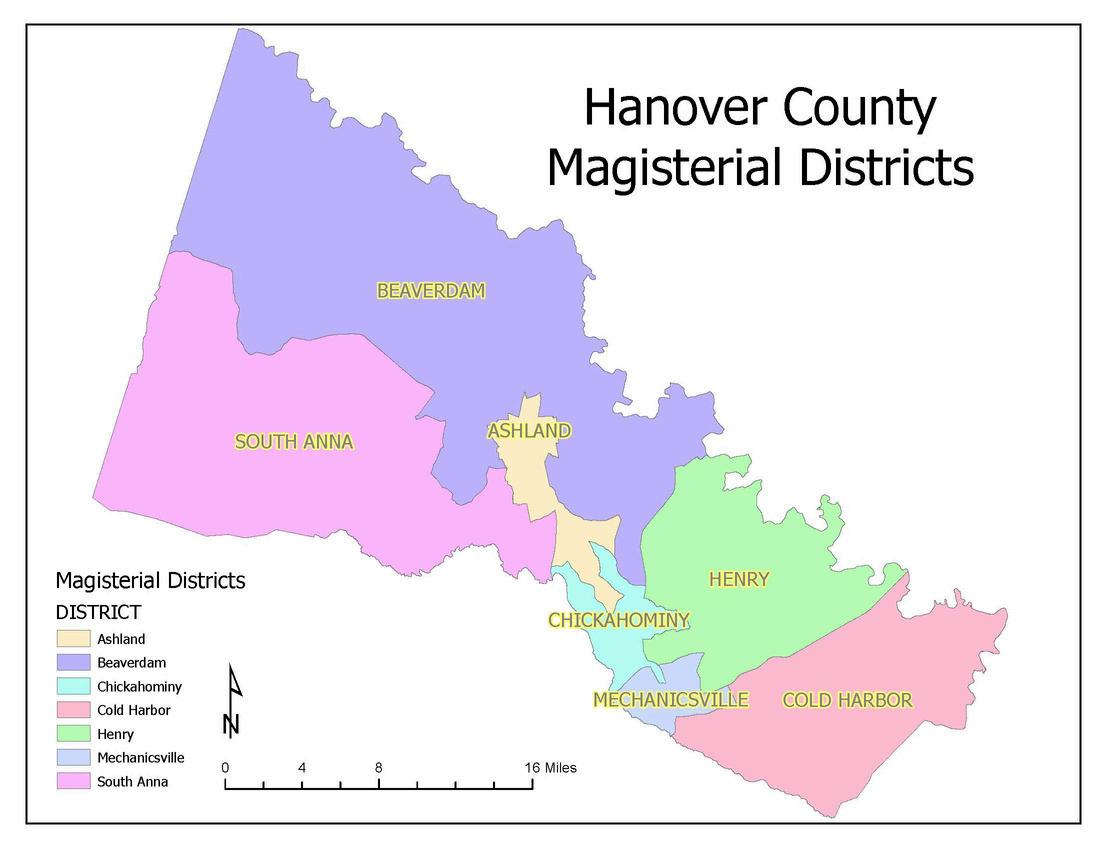
The map above highlights the boundary of Hanover County with all seven magisterial districts shown Hanover County is geographically the largest county in the Greater Richmond region, encompassing 474 square miles It is the northernmost county in the region and shares borders with the counties of Caroline, Goochland, Henrico, King William, Louisa, New Kent, and Spotsylvania Hanover County has the fourth largest population in the region, following Chesterfield County, Henrico County, and the City of Richmond
Pre-Colonial History
Prior to European settlement, the lands that now form Hanover County, Virginia were used as hunting and gathering grounds by Indigenous Algonquian-speaking peoples, especially the Pamunkey and Chickahominy tribes. These tribes lived in a rich riverine environment along the fall line of the upper Tidewater and western Piedmont, exploiting forests, streams, and fertile soils in a well-established seasonal cycle of fishing, hunting, gathering, and agriculture before the arrival of the English.
Colonial Hanover and Patrick Henry
Hanover County, established in 1720, quickly became an important center of colonial Virginia Its most famous resident, Patrick Henry, emerged from Hanover as one of the most influential voices of the American Revolution Born in 1736 at Studley plantation, Henry later lived at Scotchtown, a Hanover estate that remains a landmark today
In 1763, Henry argued the Parson’s Cause case in Hanover Courthouse, challenging royal authority by opposing the Crown’s interference in clergy pay This bold stance against the King helped establish him as a champion of colonial rights His later “Give me liberty, or give me death!” speech, delivered in Richmond in 1775, placed Hanover at the heart of the revolutionary movement and cemented Henry’s legacy as a Founding Father.
Hanover in the Civil War
During the American Civil War, Hanover’s location just north of Richmond made it a strategic military site. Numerous battles and skirmishes occurred in the county as Union forces attempted to advance on the Confederate capital.
Battle of Hanover Court House (May 27, 1862): Part of the Union’s Peninsula Campaign, where Union forces clashed with Confederates while seeking to secure supply lines
Battle of Cold Harbor (May–June 1864): One of the war’s bloodiest and most decisive battles, fought partly in Hanover The entrenched Confederate defense inflicted devastating losses on Union troops under General Ulysses S Grant
Hanover’s farms, rail lines, and crossroads were heavily impacted by troop movements and fighting, leaving a lasting imprint on the county’s landscape and historical memory
The Historic Hanover Courthouse, established around 1740, is one of the oldest in the nation

Understanding the demographic profile of Hanover County is essential to planning a parks and recreation system that is equitable, inclusive, and responsive to community needs
Demographic trends such as population growth, age distribution, household composition, and geographic dispersion directly influence the types of facilities, programs, and services residents require This section provides a snapshot of the County’s current population characteristics, highlighting key factors that shape recreational demand today and into the future These insights help ensure that investments in parks and recreation are strategically aligned with the evolving makeup of Hanover’s diverse and growing community
Population Size and Growth
Estimated 2025 population: ~115,309 residents
Hanover County has experienced steady population growth over the past two decades, averaging about 1 2–15% annual growth
Growth is primarily concentrated in the Suburban Service Area (SSA) especially Mechanicsville, Atlee, and Pole Green driven by residential development and proximity to Richmond
Age Distribution
The County has a diverse age profile, indicating demand for a wide range of recreational services:
Youth (0–17): ~21% of population
Working-age Adults (18–64): ~59%
Older Adults (65+): ~20% (and steadily increasing)
The rising older adult population suggests a growing need for low-impact recreation, accessible park design, and indoor facilities for year-round activity.
Household Composition
Average household size: 2.7 persons
Majority of households are family-based, with a significant proportion of households with children
Increasing numbers of single-person and multigenerational households indicate the need for flexible programming and diverse facilities
Racial makeup (approximate):
White (non-Hispanic): 77%
Black or African American: 14%
Hispanic or Latino: 5%
Two or more races / Other: 4%
Increasing racial and ethnic diversity points to the importance of inclusive outreach, culturally relevant programming, and language-accessible materials
Median household income: ~$96,000 (above Virginia and national averages)
Poverty rate: ~6% (lower than state average)
High levels of educational attainment, with over 90% holding a high school diploma and more than 40% with a bachelor's degree or higher
Higher income levels support willingness to invest in recreational amenities, but planners must also consider affordability and accessibility for all income levels.
Eastern Hanover is more densely populated and suburbanized. Western areas remain rural and agricultural, with limited access to neighborhood-scale parks and services.
This uneven development pattern highlights the need for strategic park placement, mobile programming, and trail connections across the county
Approximately 11% of Hanover’s population has some form of disability
Planning should prioritize ADA-compliant facilities, inclusive play structures, and accessible program offerings to serve residents of all abilities
Age diversity demands a range of facilities from playgrounds and athletic fields to walking trails and senior-friendly spaces
Population growth will increase pressure on existing parks, requiring expansion and modernization of infrastructure
Geographic disparities require targeted efforts to improve equity of access, especially in rural and lower-income areas
Cultural and demographic shifts call for programming that is inclusive, intergenerational, and responsive to evolving community interests
Overview
Hanover County has experienced consistent and moderate population growth over the past several decades, reflecting its appeal as a desirable place to live, work, and raise a family. Its strong public school system, low crime rate, access to natural resources, and proximity to Richmond have made the county a key destination for both suburban expansion and rural living
Historical Growth Trends
According to US Census data:
1990: ~63,300 residents
2000: ~86,300 residents (36% increase from 1990)
2010: ~99,800 residents (16% increase from 2000)
2020: ~109,900 residents (10% increase from 2010)
2025 (estimated): ~115,309 residents
While the rate of growth has slowed slightly over time, Hanover continues to experience steady annual population increases of approximately 1.0% to 1.5%, which remain higher than many rural and semi-rural counties in Virginia. This trend is expected to continue through at least 2045.
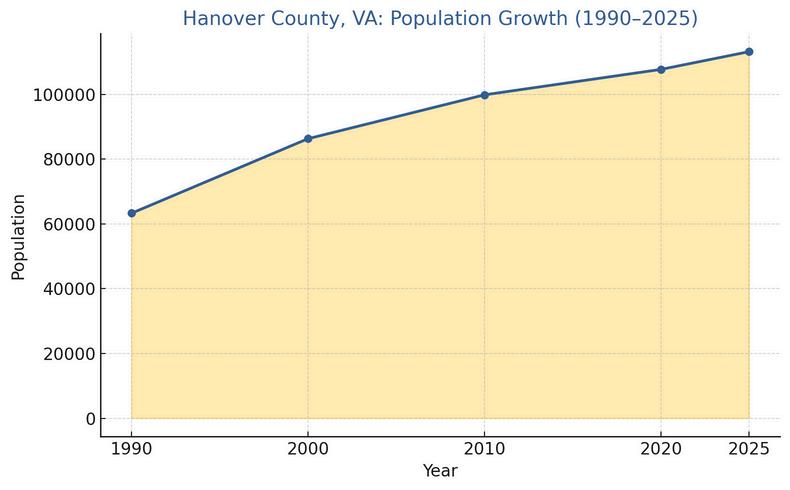
Based on data from the Weldon Cooper Center for Public Service and local planning estimates:
2030 Projection: ~120,000 residents
2040 Projection: ~127,000 residents
2045 Projection: ~131,000 residents
Much of this growth is expected to occur within the Suburban Service Area (SSA) including communities such as Mechanicsville, Atlee, and Pole Green where residential development, transportation infrastructure, and school capacity are most concentrated
Proximity to Richmond (commuting opportunities, employment access)
Attractive quality of life (schools, safety, open space)
Suburban housing demand, particularly for single-family homes
Aging in place, as older adults remain in the community longer
Incremental rural development in western Hanover

Hanover County’s steady population growth, projected to climb by nearly 20% between 2020 and 2040, has significant implications for the county’s parks and recreation system. As more residents move into both suburban and rural areas, existing facilities will experience greater pressure, particularly large hubs such as Pole Green Park, Courthouse Park, and Poor Farm Park. Athletic fields, playgrounds, trails, and dog parks will all see increased demand, requiring both expanded capacity and higher levels of maintenance investment.
This growth also underscores the importance of equitable park access While Mechanicsville and Atlee continue to attract new residents, these areas are completely lacking public park facilities With the exception of Washington Lacy Park, no public parks exist within the Suburban Services Area However, it is important to note that Pole Green Park and Hanover Wayside Park are located just outside of the SSA Ensuring that families countywide are within a short drive of recreational opportunities will require targeted and strategic land acquisition, with special focus on the Suburban Services Area The longer the county waits to secure new parkland, the more difficult and costly it will become as land prices rise along growth corridors
Changing demographics further shape recreation needs. Young families will continue to drive demand for youth sports, splash pads, and play areas, while older adults will increasingly look for accessible walking trails, passive green spaces, and fitness amenities. At the same time, a diversifying population will benefit from a broader mix of recreational and cultural facilities. The Parks and Recreation Master Plan’s emphasis on inclusive, multi-generational design becomes even more critical under these conditions.
Finally, the county’s signature events and community traditions must be considered Parks that host large gatherings, such as the Hanover Tomato Festival, will require expanded infrastructure parking, restrooms, and event spaces to handle greater crowds Investment e essential, both to connect communities and to ogether, these factors point toward a future es, and expanded programming are not optional of life as the population grows

The Town of Ashland is an independent municipality located within Hanover County, and while it governs itself, it relies on a collaborative relationship with the county for many services, including parks and recreation. Hanover County Parks and Recreation operates as the primary provider of recreational programming and maintains a network of county-owned parks and athletic facilities that serve both county residents and Ashland residents In turn, Ashland maintains its own smaller-scale facilities that primarily serve town neighborhoods
This dual structure creates both opportunities and challenges On one hand, Ashland benefits from access to the larger, county-managed facilities that support regional sports leagues, special events, and trail networks On the other, the town’s own parks complement this system by providing walkable, community-focused spaces that meet the day-to-day needs of residents Coordination between the county and town helps reduce duplication of services and ensures that resources are distributed equitably
In practice, Hanover County’s Parks and Recreation Master Plan recognizes Ashland’s unique identity while integrating it into countywide planning. The town’s parks are considered part of the broader inventory of recreational assets, and county programming is offered within Ashland in partnership with town facilities. This relationship ensures that Ashland residents receive the benefits of both local, small-town amenities and the broader scope of countywide recreational opportunities.
Town of Ashland Parks
Ashland Trolley Line Trail
Berkleytown Heritage Park
Carter Park
DeJarnette Park
Kiwanis Pufferbelly Park
Railside Park and Trail
South Taylor Street Park
Stony Run Trail
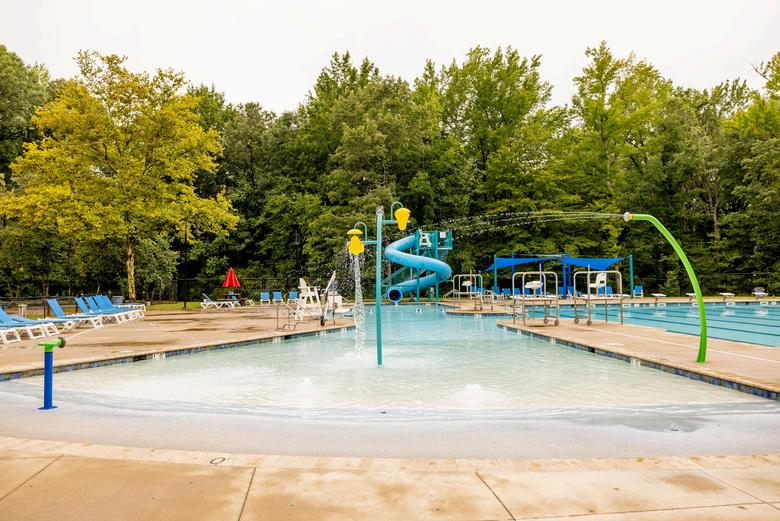
Hanover County occupies a strategic position within the greater Richmond metropolitan area. Located along the I-95 corridor, the county functions as both a suburban residential community and a gateway to rural central Virginia. Its proximity to the City of Richmond and Henrico County links Hanover directly to the region’s economic and cultural core, while its open landscapes and historic assets differentiate it from more urbanized neighbors. This dual identity positions Hanover as an important connector between metropolitan amenities and rural heritage
As one of the region’s growing counties, Hanover is absorbing significant residential development and population growth driven by metropolitan expansion This creates heightened demand for neighborhood parks, athletic facilities, and community recreation services At the same time, residents and visitors value Hanover’s preserved rural character, open space, and heritage landscapes Balancing these demands requires a parks and recreation system that supports both active urban-style amenities and passive natural and cultural resources.
Hanover’s facilities and open spaces contribute to a broader regional network of recreation opportunities. Large-scale projects like the Fall Line Trail and regional sports tourism depend on Hanover’s participation and alignment. The county’s parks serve not only local residents but also regional users who seek high-quality athletic complexes, festivals, and historic destinations Strong coordination with surrounding localities ensures Hanover remains a partner in metropolitan recreation planning
Hanover’s role in the Richmond region requires a dual strategy On one hand, the county must continue expanding active recreation opportunities to meet the needs of its growing population On the other, it must preserve and enhance open spaces, trails, and heritage landscapes that distinguish Hanover within the metro area Investments should emphasize connectivity, regional partnerships, and balance between suburban demand and rural preservation This approach will ensure Hanover’s parks and recreation system supports both its residents and the greater Richmond community

The Richmond Metropolitan Region, often referred to as the Greater Richmond area, is a diverse and interconnected region in central Virginia that blends urban, suburban, and rural communities Anchored by the City of Richmond, the state capital, the region includes the surrounding counties of Chesterfield, Henrico, Hanover, Goochland, Powhatan, New Kent, and Charles City, as well as the Town of Ashland As shown on the attached map, each locality is highlighted with distinct colors, emphasizing their geographic relationships and shared boundaries. Together, these jurisdictions form a cohesive metropolitan area that serves as a hub for government, commerce, culture, and recreation. The map illustrates how Richmond lies at the center of the region, with major suburban counties radiating outward, creating a balanced blend of dense urban development, thriving suburban neighborhoods, and expansive rural landscapes that contribute to the region’s economic vitality and quality of life.

Hanover County’s parks and recreation system is anchored by a diverse portfolio of countyowned parks, specialty sites, and undeveloped properties that together provide the foundation for recreation across the community From large-scale regional parks such as Poor Farm and Pole Green to smaller neighborhood and natural resource sites, the system offers athletic fields, trails, playgrounds, and open space that serve residents of all ages. Specialty sites such as Washington Lacy Park, the Lake Hanover Nature Trail, and river access points further enrich the system by connecting residents to the county’s natural and historic landscapes, while undeveloped sites represent opportunities for future growth as demand increases.
In addition to county facilities, Hanover benefits from a wide range of non-county recreation resources that expand opportunities for residents These include national and state-owned sites such as Beaverdam Creek Battlefield and Cold Harbor Battlefield, as well as privately managed facilities that contribute unique amenities and experiences School practice fields also play an essential role in supporting youth and adult sports by supplementing county athletic space through shared-use partnerships Together, these resources create a comprehensive network of recreation opportunities that balance daily neighborhood use with regional attractions and specialized experiences
Supporting this system is a committed workforce of 34 full-time staff, two part-time benefitted positions, and 30–40 seasonal and part-time employees, whose efforts ensure that facilities are well maintained and programs are delivered effectively. Hanover Parks and Recreation offers a wide variety of programs, activities, and community events, ranging from instructional classes and summer camps to signature events and holiday celebrations. Collectively, the facilities, partnerships, staff, and programs highlighted in this chapter define the current t th f H ’ creation system and set the stage for identifying opportunitie xpansion in the years ahead
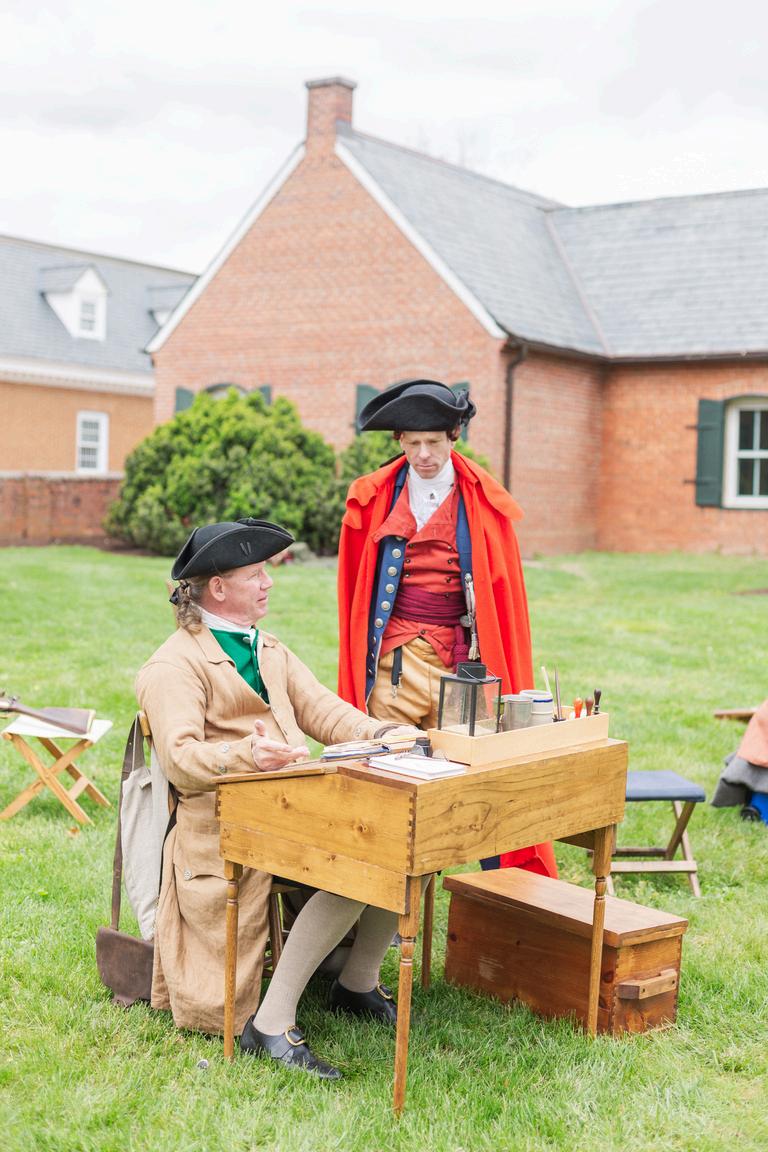

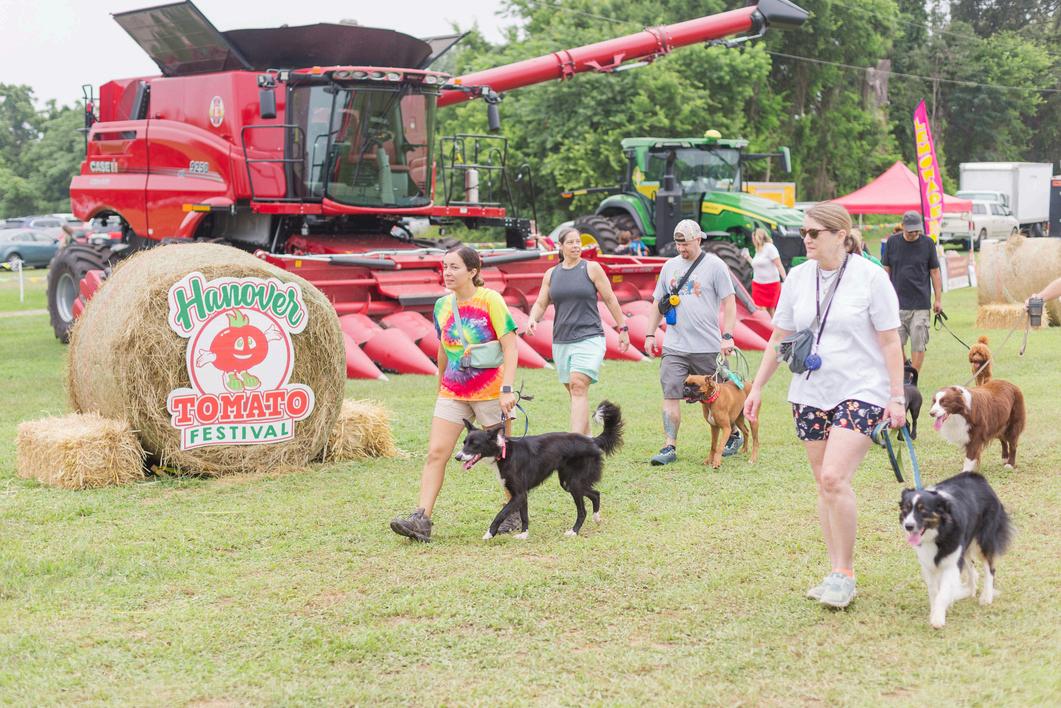
Understanding Hanover County’s existing parks and recreation resources is a critical first step in shaping the future of the system. By assessing what facilities, amenities, and open spaces are currently available, the County can identify strengths to build upon, areas that require improvement, and gaps where new opportunities are needed. This inventory not only provides a clear picture of how well current resources meet community needs, but also establishes the foundation for prioritizing investments, guiding expansion, and ensuring that Hanover’s parks and recreation system evolves in a balanced, equitable, and sustainable way
Traditional park sites are designed as versatile, multi-use spaces that serve a broad spectrum of community recreation needs They typically provide a mix of amenities such as playgrounds, sports fields, trails, and picnic areas, making them accessible and useful for residents of all ages and interests Traditional parks are usually classified as neighborhood parks, community parks, or regional parks based on size and the types of amenities available Specialty park sites are more purpose-driven, focusing on a specific resource, theme, or activity. These may include sites that provide water access for boating and fishing, historic parks that highlight cultural resources and interpretation, or natural areas set aside for environmental conservation and passive recreation.
Neighborhood Parks
1-20 acres
Neighborhood parks are usually small green spaces that serve specific neighborhoods or defined residential areas. They often include playgrounds, picnic areas, and short walking trails Some neighborhood parks may include athletic courts and other active use amenities
Community Parks
20-99 acres
Community Parks are designed to serve a collection of neighborhoods or a larger defined residential area They often include similar amenities as neighborhood parks but playgrounds, picnic facilities, and trail systems may be more robust Active recreation amenities like lighted athletic facilities are common at larger community parks
Regional Parks
100+ acres
Regional parks are designed to serve the entire community and have the ability to accommodate guests from outside of the area. These parks include traditional amenities but often feature large groupings of athletic facilities and at least one unique feature that cannot be found elsewhere in the park system.
Undeveloped Sites
3.4 Parks Reference Map
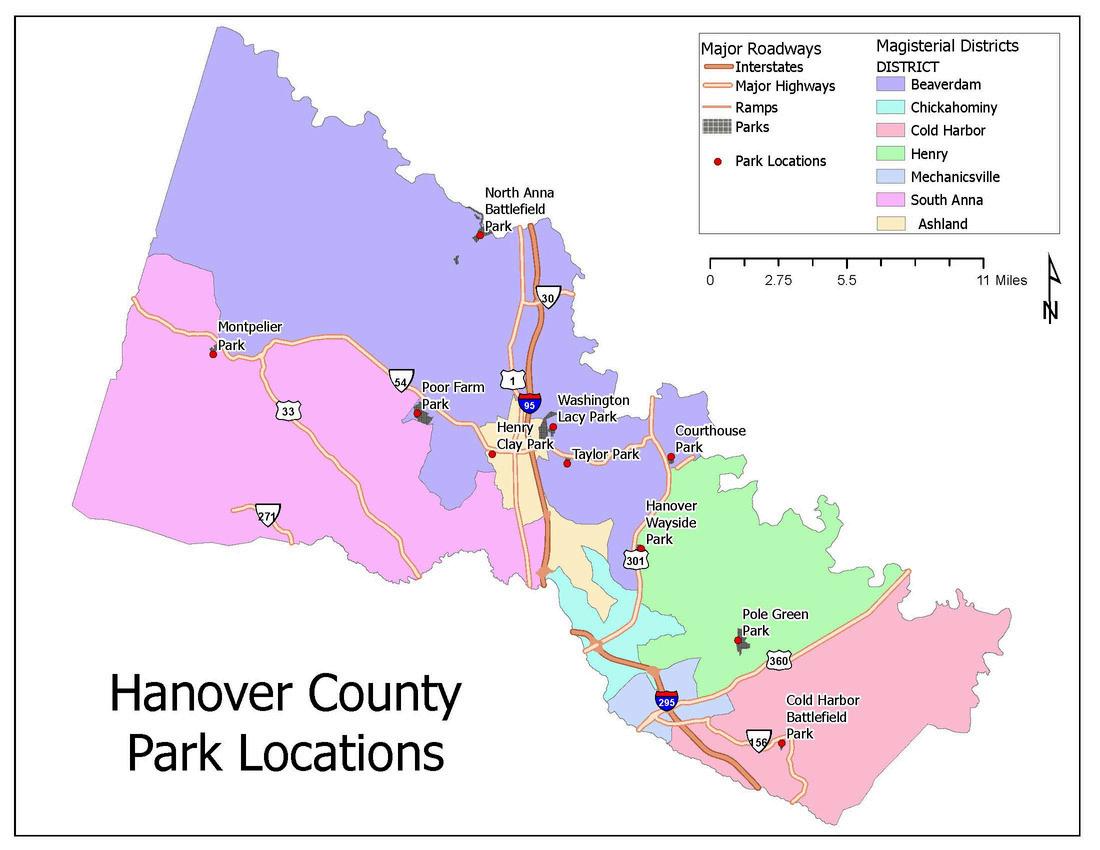
Hanover County Parks
The map above shows locations of traditional parks and specialty sites across the county
Major roadways are also shown
Pole Green Park
8996 Pole Green Park Lane
224 acres
Pole Green Park is one of Hanover County’s largest and most heavily used regional park sites, featuring an assortment of athletic facilities, nature trails, and a renowned cross country course. The park is well-suited for tournaments and community events due to its size and quality facilities. The park houses the County’s only skatepark and one of two dog parks. While fields and amenities are generally in good condition, heavy use creates ongoing maintenance needs and demand for additional field space. The park’s infrastructure is aging and accessibility challenges exist throughout.
Multipurpose fields (5)
Baseball fields (4)
Pickleball courts (4)
Dog park
Playgrounds (2)
Paved walking trails/nature trails
Picnic shelter
Cross country running course
Permanent restrooms/concession (2)
Community center
Maintenance facility
Skatepark
Volleyball court (sand)
Paved parking
Natural area

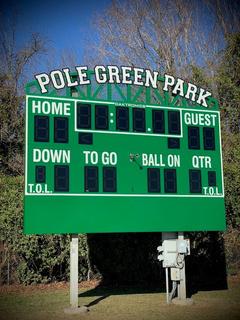
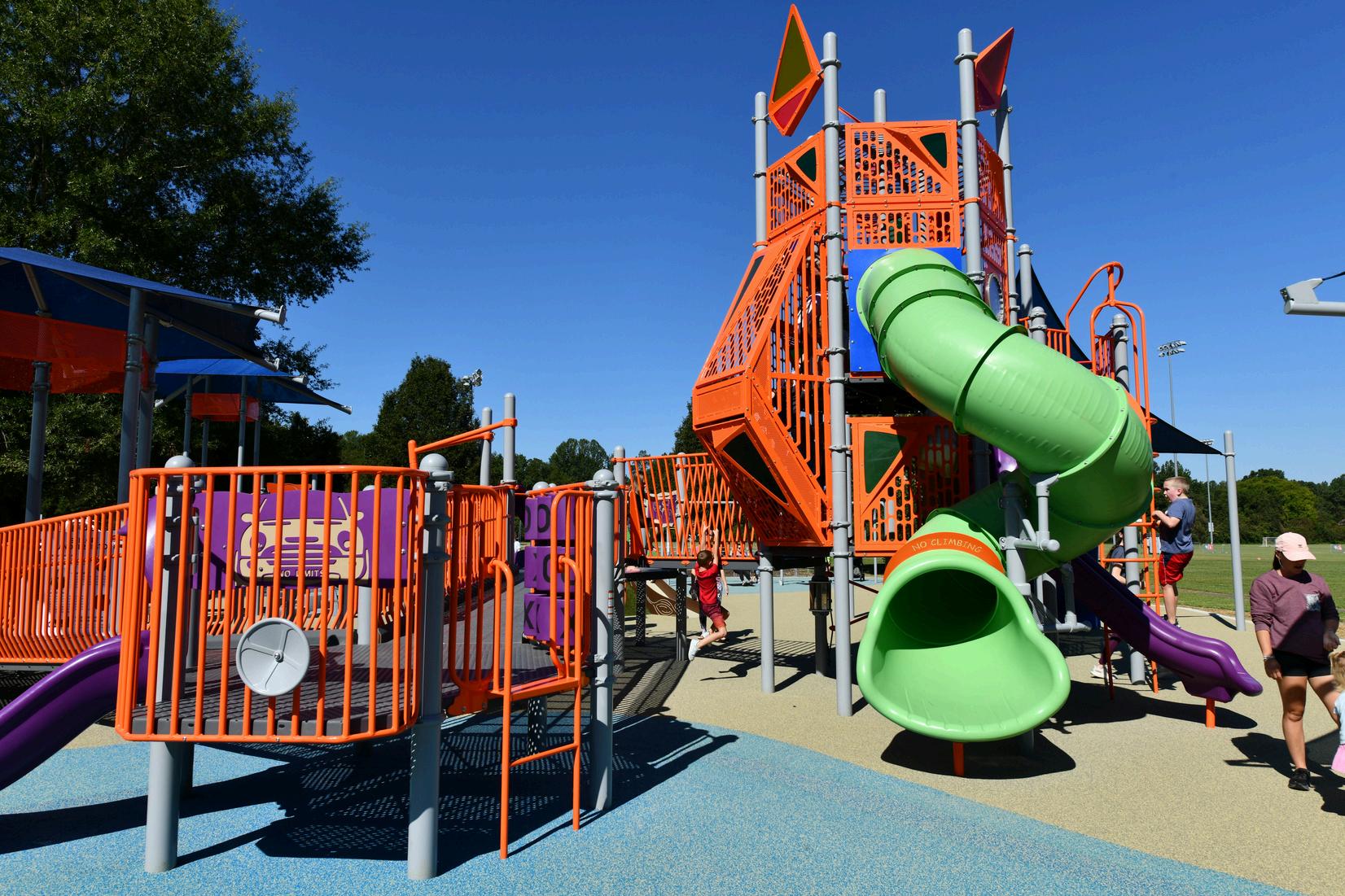
Poor Farm Park
13400 Liberty School Road
257 acres
Poor Farm Park is one of Hanover County’s busiest parks, serving both local residents and regional users. It is easily accessible from State Route 54 and located directly behind Patrick Henry High School. It was the first park established in the County’s park system in the late 1970's. Its athletic fields, natural-surface trails, and family amenities are heavily utilized. Demand for athletic field space, especially baseball fields, outpaces availability. The park has become a hub for mountain biking activities because of the large wooded area, elevation changes, and network of established trails The trail network is also popular with walkers, joggers, and wildlife enthusiasts The park’s proximity to Patrick Henry High School and Liberty Middle School further intensifies use, as school-sponsored events, practices, and overflow parking frequently overlap with community activities, compounding wear on facilities and creating circulation challenges The park’s infrastructure is aging and challenges with accessibility exist throughout
Multipurpose fields (9)
Baseball fields (4)
Permanent restrooms/concession
Playgrounds (2)
Nature trails
Mountain bike trails
Picnic shelter
Volleyball courts (2, sand)
Paved parking
Natural area
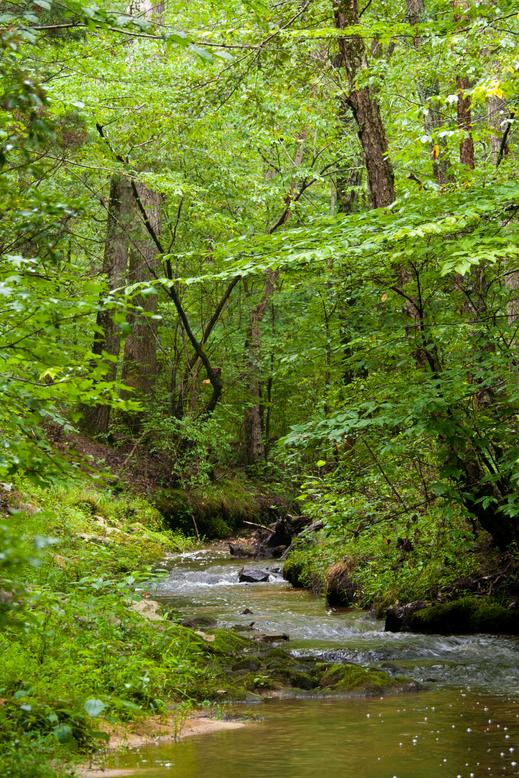
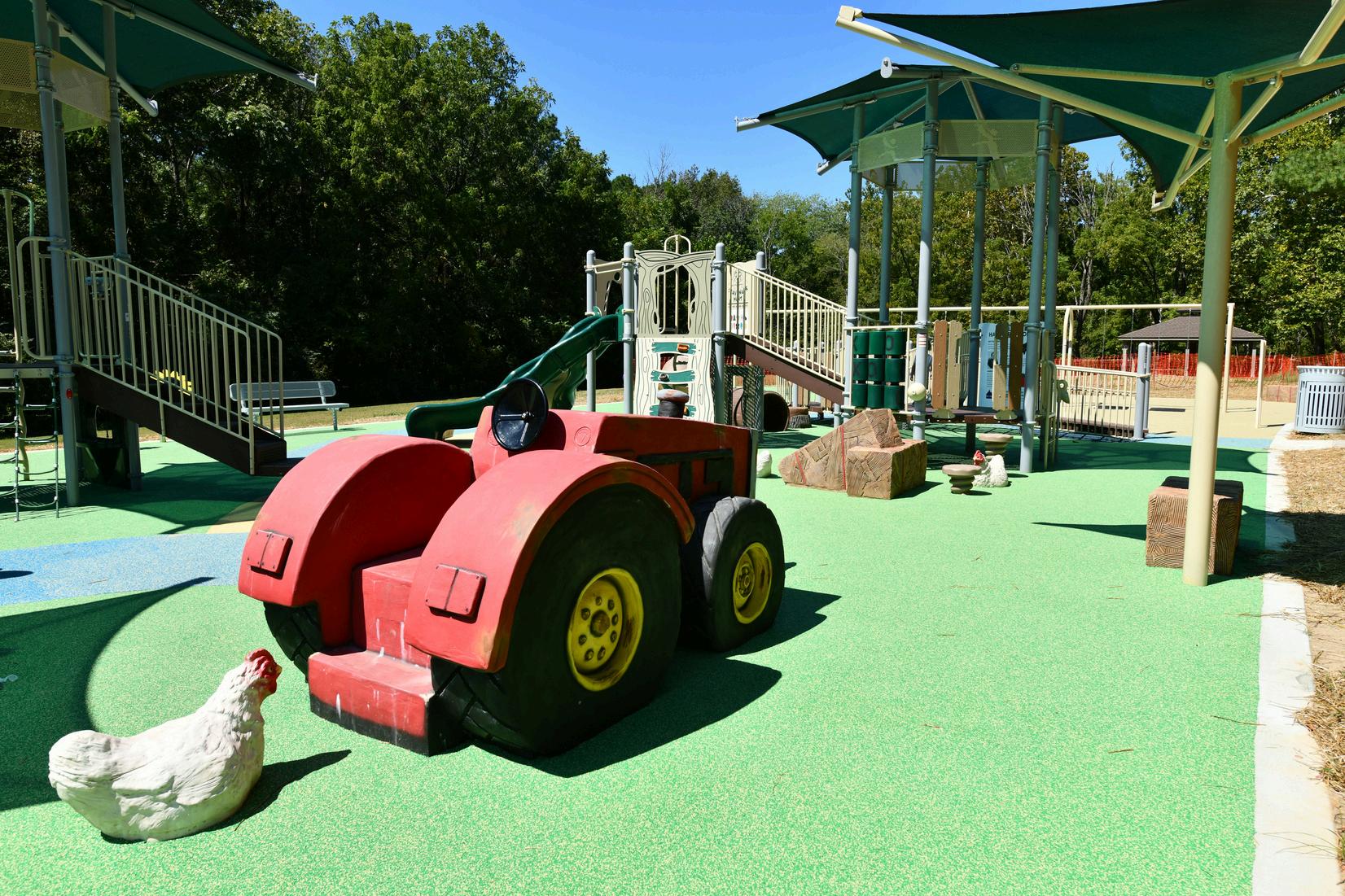
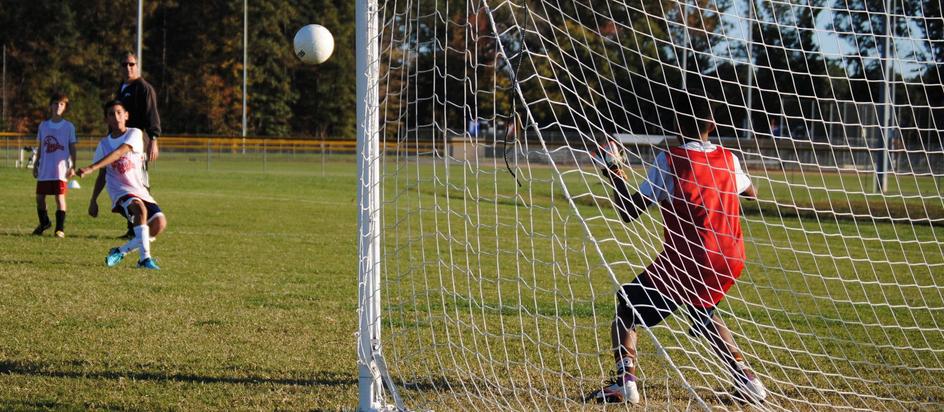
Courthouse Park
7232 Courtland Farm Road
90 acres
Courthouse Park serves as a recreation hub in central Hanover County with multipurpose athletic fields, a playground, and walking trails. One of the park system’s most unique assets, the Matthew and Daniel Barton Memorial Hockey Rink, attracts visitors from across the region. The rink was recently renovated with significant contributions from the Washington Capitals hockey organization and the community. Courthouse Park is the only park in the system to include a man-made pond with a fishing pier. The athletic fields are in good condition and well-used, though limited amenities beyond athletics reduce opportunities for broader community use
The park is also the site of the historic River Road that was used heavily during the Colonial period The old roadbed is denoted with historical markers and signage, creating a unique cultural asset at the site
Multipurpose fields (7)
Permanent restrooms/concession
Playground
Paved walking trail
Picnic shelter
Paved parking
Fishing pond
Roller hockey rink
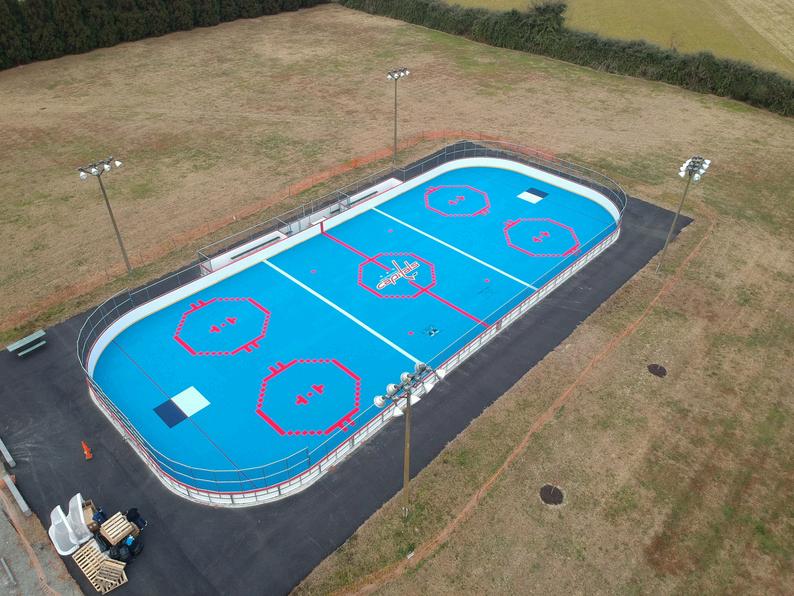
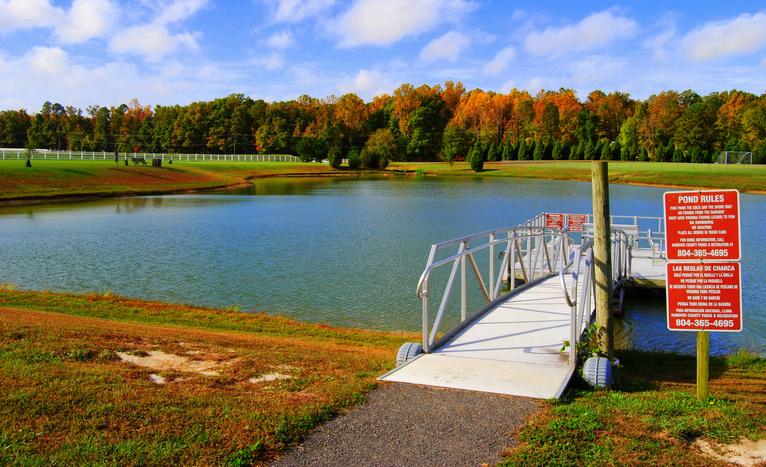
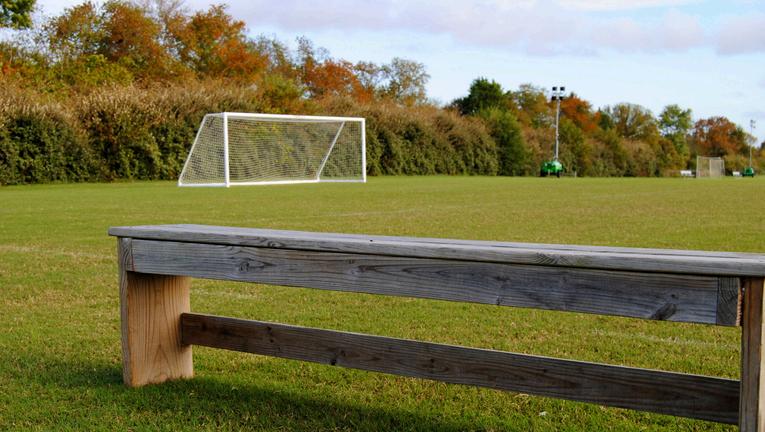
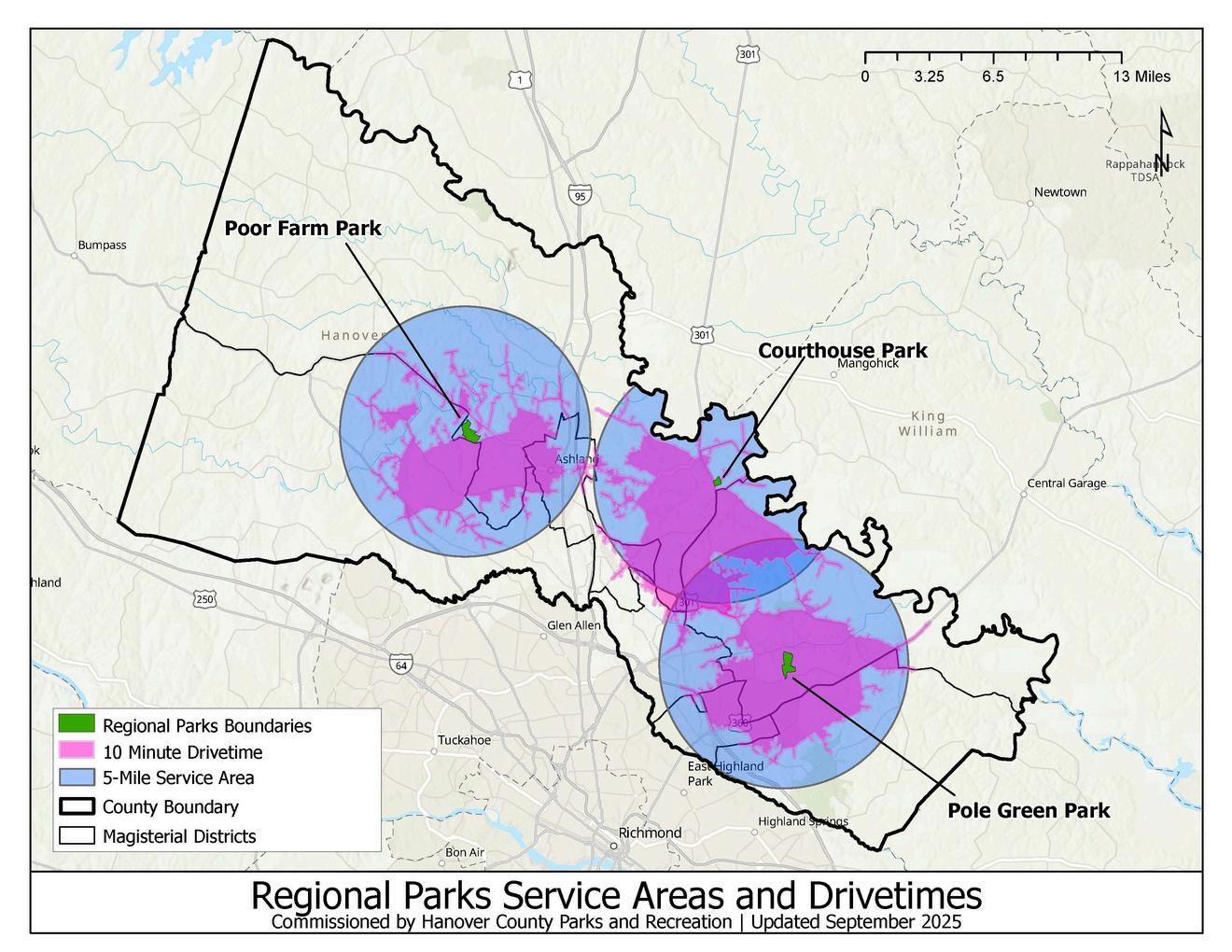
The map illustrates the service areas and drivetime accessibility for Hanover County’s three regional parks of 100 acres or more: Courthouse Park, Pole Green Park, and Poor Farm Park. Each park parcel is highlighted in green, surrounded by 10-minute drivetime zones and 5-mile service area buffers. The shaded areas show how well these parks serve nearby communities, with some overlap in central Hanover. All three of these parks see high volumes of use, especially related to athletic events on evenings and weekends. Field use requests at Courthouse Park and Pole Green Park regularly exceed available field space. Poor Farm Park offers the most scheduling availability due to the presence of nine multipurpose fields, the most of any County park
Hanover Wayside Park
8225 Hanover Wayside Road
36 acres
Hanover Wayside Park is a small but highly visible park located along U.S. Route 301. It offers picnic shelters, trails, and a naturally shaded playground. The park’s strengths lie in its natural setting and tranquil atmosphere. However, facilities are limited, with aging shelters and an unorganized trail network. The site offers many opportunities for improvement to become an ideal community park.
Picnic shelters
Playground
Nature trails
Volleyball court
Natural area
Hanover Veterans Memorial
Taylor Park
13017 Taylor Complex Lane
53 acres
Taylor Park is a small community park with limited amenitie the dog park and playground, while the single multipurpose weekday evenings and weekends mostly for youth soccer The park is a shared space that also houses the Virginia Cooperative Extension Office, Hanover Animal Protection and Shelter, and the Parks and Recreation central maintenance facility.
Multipurpose field
Dog Park
Maintenance facility
Walking trail
Picnic shelter
Playground


3.5 Parks Inventory (continued)
Montpelier Park
17203 Sycamore Tavern Lane
50 acres
Montpelier Park is transitioning into a modern community destination with the recent opening of the Montpelier Recreation Center and Library. The facility offers a gymnasium, expanded library, classrooms, and flexible programming space. Adjacent to the center, Wickham Field provides lighted athletic opportunities, though it is undergoing reconstruction. The park’s future potential is strong, but completion of field improvements and development of supporting outdoor amenities will be key to maximizing community benefit
Multipurpose field
Baseball field
Recreation center
Permanent restrooms/concession
Playground
Picnic shelter
Paved walking/nature trail
Natural area
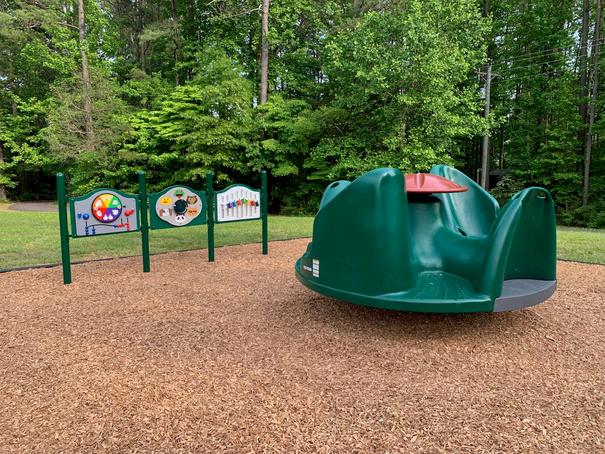

3.5 Parks Inventory (continued)

The map illustrates the service areas and drivetime accessibility for Hanover County’s three community parks: Hanover Wayside Park, Montpelier Park, and Taylor Park. Each park is highlighted with a green boundary, surrounded by 5-minute drivetime zones and 3-mile service area buffers. The shaded areas show how well these parks serve nearby communities, with some overlap in central Hanover. This visualization helps identify the areas served well by community parks. It also highlights gaps in service in areas like Cold Harbor, Beaverdam, Doswell, Elmont, Mechanicsville, and Rockville.
Cold Harbor Battlefield Park
6005 Cold Harbor Road
50 acres
Cold Harbor Battlefield Park is a historically significant site that preserves key Civil War landscapes adjacent to National Park Service property. Expanded recreational opportunities are not possible given the historical sensitivity of the area.
Paved walking trail
Interpretive signage
Picnic areas
Henry Clay Elementary School Baseball Fields
208 Hanover Avenue
3 acres
Following the closure of Henry Clay Elementary School in 2024, the baseball fields at the corner of Snead Street and Hanover Avenue have been incorporated into Hanover County’s park system as a specialty athletic site The site needs a formal plan of redevelopment to address issues with aging infrastructure, accessibility, and parking
Baseball fields (2)
Permanent restrooms
Lake Hanover Nature Trail
7494 Library Drive
81 acres (approximate)
The Lake Hanover Nature Trail offers a scenic, passive recreation opportunity at the Hanover County Government Complex. Total acreage for this site is approximate as it is part of the larger government complex parcel The site offers potential to establish a larger conservation area that preserves and protects unused areas of the parcel, including wetlands that are vital to migratory bird populations
Nature trail
Scenic overlooks (2)
North Anna Battlefield Park
11576 Verdon Road
172 acres
North Anna Battlefield Park features a tranquil nature trail that protects and preserves important Civil War landscapes. The trail system includes interpretive signage that explains the historical importance of the site. The park is popular with hikers because of its natural beauty. The site does not offer any additional recreational opportunities due to the sensitivity of the historic area.
Nature trail
Interpretive signage
Picnic areas
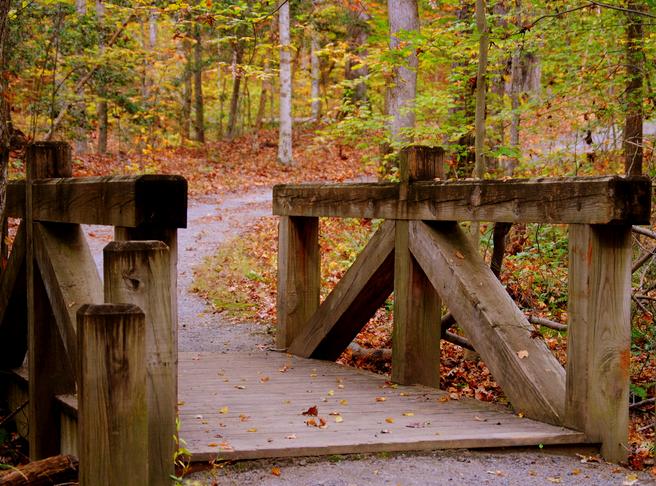
Washington Lacy Park
13400 Woodside Lane
216 acres
Although Washington Lacy Park is large in terms of acreage, it is mostly undeveloped and offers very limited recreational amenities The park is unique in that it exists both in Hanover County and the Town of Ashland. The park’s primary offering is equestrian trails and nature trails. Use of these trails is limited and this park is one of the least visited in the County’s system. The park offers the opportunity for expanded recreational activities but careful consideration should be given to its proximity to Taylor Park, only one mile away.
Equestrian trail
Nature trail
Picnic shelter

3.5 Parks Inventory (continued)

The map of Hanover County’s specialty park sites identifies unique recreational and historical resources spread across the county. Locations include South Anna–Ground Squirrel Boat Ramp, North Anna Battlefield Park, Washington Lacy Park, Cold Harbor Battlefield Park, and the Henry Clay School site. These sites are distributed to highlight both natural amenities and significant cultural landmarks, offering specialized experiences beyond the county’s regional and community parks. The visualization underscores the diversity of park resources available while also showing their geographic spread across Hanover County.
GPIN 7796-99-6627 18 acres
Although not formally named, the Chickahominy Park site offers 18 wooded acres adjacent to Atlee High School and Cool Spring Elementary School An informal trail network at the site is already in use by the surrounding community and students Topography and wetlands make future development of this park challenging for anything more than a nature trail Access to the site for general public use must be taken into careful consideration due to its proximity to school property.
12205 New Market Mill Road 22 acres
The Little River site has been envisioned for park development since the late 1970's. The site’s most impressive feature is the falls of the Little River, where the river cascades over large granite boulders and drops almost 50 feet in elevation. The site is also historically rich as the home seat of the Doswell family for whom the surrounding area is named. The site also contains stone ruins from 19 century mill works Development of the th site has been hampered by accessibility and topography Future development should focus on environmental conservation and historical preservation, supporting passive recreational uses The site does not offer opportunities for active recreation pursuits such as athletic facilities
GPIN 7788-52-6309 47 acres

The Winding Brook site was donated to the County as part of the development of the Bass Pro Shops store in 2012 The site consists mostly of a linear parcel that follows a portion of Lickinghole Creek and a small tributary The site offers limited future development opportunities and should remain focused on conservation efforts, particularly as the surrounding area continues to grow. The site may be suitable for a greenway trail, which could eventually connect to a larger trail network.
Hanover County’s indoor recreation spaces provide important venues for community gatherings, programs, and events, complementing the county’s outdoor park system In comparison to some neighboring localities, Hanover’s indoor facilities are limited. For many years, the department has relied on shared use of school spaces and use of private facilities to meet indoor space needs.
15302 Clazemont Road
20,000 sf
The Montpelier Recreation Center and Library serves as a hub for western Hanover, combining recreational programming space with library services in a shared facility that supports both leisure and lifelong learning This unique facility is the first of its kind in the region and the first purpose-built indoor recreation facility in the Department’s history. It includes a full-size gymnasium and classroom space that are both operated by Hanover County Parks and Recreation The gym is marked for basketball, pickleball, and volleyball and includes a small stage The classroom accommodates groups of up to 40 persons for classes, activities, and meetings


17203 Sycamore Tavern Lane
2,100 sf

The Montpelier Community Center is located next to the Montpelier Recreation Center and was originally the cafeteria for the first Montpelier School The building houses a large multipurpose room, restrooms, and a full kitchen. It is primarily used for departmentsponsored programming and Montpelier Ruritan Club activities
Pole Green Community Center
8996 Pole Green Park Lane
5,000 sf
The Pole Green Community Center is a repurposed private residence that offers indoor space for small classes and meetings.

The map highlights the location and service area of Hanover County’s single recreation center, the Montpelier Recreation Center and Library. Shown with a yellow star and a 10-mile buffer, the map illustrates the facility’s reach within the western portion of the county. While this visualization demonstrates the center’s broad service area, it also emphasizes the lack of other recreation centers across Hanover. Community centers are not depicted on this map, as their smaller size and more limited accessibility distinguish them from the county’s primary recreation facility.
National and State Recreation Sites
Hanover is fortunate to have several federal and state-owned recreational facilities within the County. These facilities serve very specific purposes but contribute to the overall comprehensive recreational facility inventory. These facilities are detailed below.
National Park Service
The National Park Service operates the Richmond National Battlefield Park, which consists of multiple historic sites throughout the region These sites exist to preserve the landscape of the American Civil War and often feature hiking trails, interpretive signage, earthworks, and historic buildings There are no opportunities for active recreation at these sites Other than battlefield sites, there are no National Parks located in Hanover County
Richmond National Battlefield Park Hanover Sites
Beaver Dam Creek
Cold Harbor
Gaines’ Mill
Garthright House
Totopotomoy Creek at Rural Plains
Virginia Department of Wildlife Resources
The Virginia Department of Wildlife Resources helped establish three boat ramps throughout the County in the 1990's The boat ramps are intended to provide water access for small craft like canoes and kayaks, as well as bank fishing opportunities These boat ramp sites do not offer any amenities beyond access to rivers and gravel parking areas They exist entirely within state-owned right-of-way There are no state parks operated by the Department of Conservation and Recreation located in Hanover County
DWR Boat Ramp Sites
North Anna Ramp (State Route 1)
South Anna Ramp (State Route 33)
Pamunkey Ramp (State Route 301)
*Note: the South Anna Boat Ramp located on State Route 54 is County-owned property. Therefore, it is included with “Other County Facilities” in the Existing Resources chapter.
Hanover County is fortunate to have a variety of private recreational facilities located throughout the County, which contribute to active living opportunities and overall quality of life In some instances the Department of Parks and Recreation may collaborate or formally partner with some of these entities
The Mechanicsville Little League and Atlee Little League operate independently and do not rely on County facilities. Both organizations support robust baseball and softball programs. Additionally, Sports Reality Performance Training is a private indoor facility that supports a wide range of athletic training programs. The Rockville Youth Association also manages and maintains athletic facilities located on County-owned property through a formal shared use agreement. Hanover County Parks and Recreation does not provide support in terms of operations or facility maintenance at the Rockville School Park site.
YMCA’s
Hanover has two YMCA facilities - the Atlee Station YMCA in Atlee and the Patrick Henry YMCA in the Town of Ashland The Atlee Station YMCA does not offer a gymnasium or pool, but does provide a wide range of fitness programs and limited youth athletic opportunities The Patrick Henry YMCA is a full-service facility with a gym, pool, fitness equipment, and a wide range of program offerings
Several places of worship in Hanover County offer robust recreational opportunities with large athletic facilities Examples include Cool Spring Baptist Church, which operates a 40,000 sf recreation and fitness facility, and the Compass Sports Program.
Hanover County Parks and Recreation does not offer any aquatic facilities, including pools and splash pads. The Town of Ashland, through its Parks and Recreation Department, offers a community pool at Carter Park. Several private community pools are available throughout the County. Examples include the Mechanicsville Recreation Association, the Atlee Recreation Association, and the Rockville Center Additionally, many subdivisions offer their own private aquatic facilities available only to residents of the neighborhood and their guests
There are a range of commercial fitness facilities located throughout the county These facilities are primarily located in Mechanicsville, Atlee, and Ashland They include both national chains and small, locally-owned businesses
The Fall Line Trail is a transformative 43-mile multi-use corridor connecting Ashland to Petersburg, Virginia, passing through Hanover County. The trail aims to serve as a regional spine for active transportation, linking various communities and enhancing connectivity across Central Virginia. In Hanover County, the trail extends approximately 4.8 miles, beginning at the Ashland Trolley Line Trail and progressing southward toward Woodman Road in Henrico County Hanover’s section of the trail was officially opened on September 24, 2025 Additional trail sections in the counties of Henrico and Chesterfield and cities of Richmond, Colonial Heights, and Petersburg will be completed over the next several years
The Fall Line Trail's development is a collaborative effort involving multiple jurisdictions, including Hanover County, the Virginia Department of Transportation (VDOT), and regional planning organizations The trail's design considers the unique geological and historical features of the Fall Line region, incorporating elements such as boardwalks and interpretive signage to enhance the user experience As the trail progresses, it is expected to serve as a catalyst for economic development, tourism, and improved quality of life for the communities it traverses.
U.S. Bicycle Route 1 (USBR 1) and U.S. Bicycle Route 76 (USBR 76) are part of the United States Bicycle Route System, a developing national network of long-distance, signed bicycle routes that connect urban and rural communities across the country. USBR 1 runs along the eastern seaboard from Key West, Florida, to Calais, Maine, while USBR 76, also known as the TransAmerica Trail, stretches from Astoria, Oregon, to Yorktown, Virginia, crossing diverse landscapes and states Complementing these routes, the East Coast Greenway (ECG) is a 3,000-mile multi-use trail that parallels much of the eastern seaboard, connecting 15 states and hundreds of communities from Maine to Florida Together, these trails and routes provide cyclists with a continuous network for recreation, commuting, and long-distance travel, linking regional trails, parks, and urban centers along the eastern United States
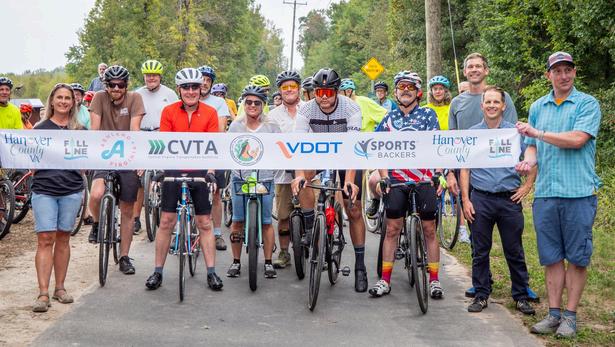

Hanover County Parks and Recreation is supported by a dedicated team that balances professional expertise with flexible staffing to meet community needs. The department employs 34 full-time benefitted staff who provide leadership, programming, maintenance, and administrative support, along with two part-time benefitted positions that add support services. To deliver summer camp programming, special events, and year-round facility operations, the department also relies on a dynamic workforce of 30 to 40 part-time nonbenefitted employees, allowing for adaptability during peak seasons and special events Together, these personnel resources form the foundation for delivering high-quality recreational services and maintaining the county’s parks and facilities
Staff are divided into three main operating divisions:
Administrative Services Divisions
Includes customer service personnel and is led by the Business Manager
Serves as frontline staff and assists with business, clerical, and financial management functions
Park Services Division
Includes groundskeepers, supervisors, maintenance managers, and maintenance service technicians and is led by one of two deputy directors
Performs a wide range of maintenance functions from grounds maintenance operations to mechanical repairs and light trade work
Responsible for grounds maintenance at all parks, libraries, schools, and government facilities
Oversees a variety of park improvement, repair, and maintenance projects carried out by contractual vendors
Manages a large fleet of maintenance equipment including mowers, tractors, heavy equipment, utility vehicles, and assorted power tools
Responsible for special assignments including snow removal at all government facilities and election equipment logistics
Recreation Services Division
Includes recreation managers, recreation coordinators, and a program assistant and is led by one of two deputy directors
Includes the majority of part-time, non-benefitted personnel
Facilitates a wide range of programs, activities, facility operations, and special events
Works closely with a variety of vendors and contractual service providers
Supports community engagement efforts with a variety of stakeholder groups
Includes the Hanover Museum of History and Culture, led by the museum manager
An organizational chart is an essential tool for illustrating the structure of a department, showing how responsibilities are distributed and how lines of communication flow. By clearly defining reporting relationships and functional roles, the chart helps staff, leadership, and stakeholders understand how the organization operates on a daily basis
In addition to clarifying the current structure, an organizational chart is valuable for planning future growth It allows leaders to identify gaps in staffing, areas where workloads may be concentrated, and functions that may require additional support as programs expand. By mapping out potential new positions or divisions, the chart provides a visual framework for scaling services strategically, ensuring that growth is both efficient and aligned with community needs





































































Hanover County Parks and Recreation offers a wide variety of programs, classes, and special events designed to engage residents of all ages and interests throughout the year. From youth summer camps and special interest classes to sports programs and adaptive recreation, the department provides opportunities that promote health, creativity, social engagement, and lifelong learning. Signature special events such as the Hanover Tomato Festival further strengthen community connections and showcase Hanover’s unique character Together, these offerings create a vibrant calendar of recreation experiences that complement the county’s parks and facilities and foster a strong sense of community pride
Special events are large community celebrations that are often offered free of charge and open to the entire community They are typically themed around a shared community interest or a specific season They include a range of activities meant to serve a large audience These events usually require a large manpower complement from the department, utilizing staff from all three operating divisions For the largest events, public safety agencies, volunteers, and community organizations also provide support functions.
Signature Events
History and Hops
Hanover Tomato Festival
SpookyFUN Fest
Winter on the Green
Other Community Events
Classic Car Cruise In Memorial Day Ceremony
Summer Splash Party
Montpelier Monster Mash
Veterans Day Ceremony
Frozen Frenzy

Although manpower intensive and costly, special events allow the department to reach a large audience in a single effort. Events foster a strong sense of community pride while celebrating what makes communities special. Events are an integral part of the service delivery provided by Hanover County Parks and Recreation.
Community recreation refers to the wide range of programs and activities offered through a parks and recreation department that bring people together for play, learning, fitness, and social connection. Unlike facilities or infrastructure, community recreation focuses on the experiences that activate spaces and directly enrich residents’ daily lives. It is an integral part of service delivery because it fosters inclusion, promotes health and wellness, supports youth development, and strengthens community identity. By offering opportunities that serve all ages and interests, community recreation ensures that parks are not just places to visit, but vital community hubs that enhance quality of life
Day camp programs provide safe, engaging, and affordable opportunities for children and youth to learn, play, and grow during the summer months Camps are typically designed for rising first graders through early teens and are staffed by trained recreation leaders who guide participants through a variety of activities These camps emphasize fun, skill-building, and social interaction while supporting working families with structured, supervised daytime care
Adaptive recreation in Hanover County Parks and Recreation refers to programs, activities, and services designed to ensure that individuals with disabilities have equitable opportunities to participate in leisure and recreation. These offerings are adapted to meet a variety of physical, developmental, and cognitive needs, often through modified equipment, adjusted rules, smaller class sizes, or additional staff support. The department provides both inclusive programs, where participants with and without disabilities engage together, and specialized programs that offer targeted experiences By prioritizing accessibility, inclusion, and individualized support, Hanover’s adaptive recreation services promote independence, social interaction, skill development, and overall quality of life for participants and their families


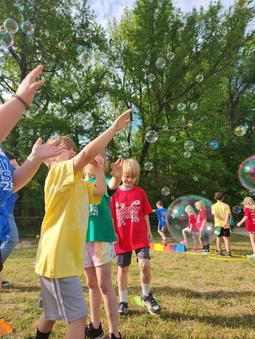
Imaginative play in Hanover County Parks and Recreation refers to recreation opportunities that encourage children to use creativity, storytelling, and role-playing as part of their play experience. These programs and activities often feature unstructured or lightly guided environments such as themed camps, nature-based play areas, or interactive events where children can explore, pretend, and invent their own games and scenarios. Imaginative play supports healthy childhood development by fostering problem-solving, self-expression, and social skills, while also inspiring a sense of wonder and discovery in the park setting. By incorporating imaginative play into its offerings, Hanover Parks and Recreation ensures that children have opportunities for fun that go beyond athletics and structured activities, nurturing creativity as an essential part of recreation
Sports and fitness programs offered by Hanover County Parks and Recreation provide residents of all ages with opportunities to stay active, build skills, and enjoy healthy competition in a supportive community environment These programs include instructional classes, youth and adult leagues, clinics, and open-play opportunities across a variety of sports such as basketball, volleyball, softball, soccer, tennis, and pickleball. Fitness offerings may include group exercise, wellness classes, and recreational activities designed to improve strength, flexibility, and overall health. By promoting active lifestyles, encouraging teamwork, and creating accessible pathways for lifelong physical activity, Hanover’s sports and fitness programs serve as a cornerstone of the department’s mission to enhance community wellness and quality of life.
Creative arts programs offered by Hanover County Parks and Recreation provide opportunities for residents of all ages to explore self-expression, develop new skills, and experience the joy of artistic creation These programs may include visual arts, music, dance, theater, crafts, and cultural activities that range from introductory classes and workshops to more specialized instruction By fostering imagination and creativity in accessible, community-based settings, the department ensures that the arts are available to everyone, not just through schools or professional organizations Creative arts programs not only enrich individual lives but also strengthen community identity by celebrating talent, diversity, and shared cultural experiences
The Department attends a wide variety of school functions, civic meetings, and club gatherings to promote its programs and events while connecting face-to-face with members of the community.
Social engagement programs offered by Hanover County Parks and Recreation are designed to foster connection, community, and lifelong learning, with a strong emphasis on serving older adults ages 50 and above. These programs create welcoming opportunities for participants to gather, share experiences, and build friendships through activities such as group outings, clubs, hobby-based gatherings, educational workshops, and social events. By prioritizing accessibility and inclusivity, social engagement programs help reduce isolation, support mental and emotional well-being, and promote active aging. For many older adults in Hanover, these offerings provide not only recreation but also a vital sense of belonging and connection to the broader community
Nature and outdoor recreation programs offered by Hanover County Parks and Recreation provide residents with opportunities to connect with the natural environment while promoting health, education, and appreciation of the county’s outdoor resources These programs may include guided hikes, wildlife observation, environmental education workshops, outdoor skills classes, and nature-based play experiences for children By encouraging exploration of trails, rivers, and park landscapes, these offerings help participants develop a deeper understanding of conservation, stewardship, and the benefits of time spent outdoors. Nature and outdoor recreation programs also support physical activity and wellness, offering meaningful alternatives to traditional indoor or athletic programming while showcasing Hanover’s unique natural assets.
History and cultural programs offered by Hanover County Parks and Recreation provide opportunities for residents and visitors to explore Hanover’s rich heritage and diverse traditions through engaging, educational, and interactive experiences These programs include lectures, exhibits, living history demonstrations, heritage tours, and cultural celebrations that highlight both local history and broader cultural perspectives A central hub for these activities is the Hanover Museum of History and Cult which the department operates as a dedicated space for preserving artifacts, telling the county’s stories, and hosting cultural programming that connects past and present By offering history and cultural programs, Hanover Parks and Recreation fosters community pride, encourages lifelong learning, and strengthens the county’s identity through shared experiences that honor its unique legacy and growing diversity.

Hanover County’s existing parks and recreation resources form the foundation of the county’s quality of life, community identity, and overall well-being. The county’s park system includes a diverse range of sites community parks, neighborhood parks, specialty facilities, and undeveloped sites that provide vital spaces for athletic play, outdoor recreation, social gatherings, and connection with nature. Together, these parks not only offer places for exercise and relaxation but also serve as hubs of community activity that promote health, inclusion, and pride in place In addition to county-owned facilities, school practice fields play an important complementary role by expanding the available space for youth and adult sports, reflecting a critical partnership between education and recreation in serving Hanover’s residents
Supporting these sites is a dedicated team of parks and recreation personnel, including 34 full-time benefitted positions, two part-time benefitted positions, and 30–40 part-time nonbenefitted positions This workforce provides leadership, facility management, maintenance, programming, and customer service, ensuring that the county’s investments in land and facilities are matched by high-quality service delivery. Their adaptability and commitment allow Hanover to meet seasonal demands, expand offerings, and sustain a safe, welcoming system for all users.
Equally important are Hanover’s programs and special events, which activate these spaces and create memorable experiences. From sports leagues, fitness programs, and summer camps to creative arts, adaptive recreation, cultural events, and community celebrations, the department offers inclusive opportunities for all ages and interests Signature special events bring residents together and strengthen community bonds, while ongoing classes and programs provide daily opportunities for enrichment, wellness, and social connection Collectively, these offerings transform Hanover’s parks into dynamic centers of community life, underscoring the vital role that existing resources play in supporting both current needs and the county’s long-term vision for growth and vitality.


A community needs assessment is a critical tool in the development of the Hanover County Parks and Recreation Master Plan because it ensures that planning decisions are rooted in the priorities, expectations, and lived experiences of residents By systematically identifying what services, facilities, and programs are most valued and where gaps exist the assessment provides a clear picture of how well current resources align with community demand This process helps guide investment decisions, establish priorities, and support equitable distribution of parks and recreation opportunities across the county.
Common parts of a community needs assessment include:
Demographic analysis, to understand who the county serves and how population trends may shape future needs.
Benchmarking, to evaluate existing parks, facilities, and spending against national standards
Public engagement, such as surveys, focus groups, and community meetings, to gather direct input from residents, stakeholders, and partner organizations
Gap analysis, comparing existing resources with current and projected needs
Recommendations and priorities, which translate findings into actionable strategies for future park development, staffing, and programming
For Hanover County, the needs assessment is especially important given the county’s growth, changing demographics, and emerging recreation trends such as demand for pickleball, splash pads, mountain biking trails, and expanded athletic facilities. By capturing both quantitative data and community perspectives, the assessment ensures that the Master Plan reflects not only best practices but also the unique character and values of Hanover.
Understanding Hanover County’s demographic profile is essential to shaping a responsive and future-focused Parks and Recreation Master Plan. With steady population growth, a balanced age distribution, and an increasingly diverse mix of families, working-age adults, and older residents, the county reflects both expanding demand and evolving recreational needs. High household incomes, strong homeownership rates, and a relatively low poverty rate further indicate both the community’s capacity and expectations for high-quality facilities and programs This demographic context provides the foundation for identifying priorities, ensuring equitable service delivery, and planning for facilities and programs that meet the needs of all residents
As of July 2024, Hanover County’s estimated population stands at approximately 115,309, up from 109,979 in April 2020 representing a growth rate of just over 1% annually
The area continues to grow steadily, showing both suburban expansion and steady appeal for new residents in the Richmond metro region
The population is fairly balanced between age groups:
Children (0–17 years): ~21%
Adults (18–64 years): ~59%
Seniors (65+ years): ~20%
The most populous age group is 55–59, comprising nearly 8% of residents
The median age is approximately 42–43 years, which is higher than both the Virginia and national averages (generally near 39)
Median household income is robust at about $109,504 (2019–2023 data), markedly higher than statewide and national averages
Per capita income is about $51,509, again exceeding broader benchmarks
Only around 53% of residents live below the poverty line, significantly lower than Virginia and U.S. averages
Homeownership is high (over 80%), and the county reports strong housing values and stability
The population also includes a stable and aging demographic, with an increasing share of older adults suggesting growing demand for senior-friendly recreational services
Implications for Parks and Recreation
Youth and family demand: With around 22% of the population under 18, there remains strong demand for youth programs like sports, camps, playgrounds, and family-oriented amenities.
Adult and wellness focus: The substantial 18–64 cohort supports active recreation, fitness offerings, and skill-building programs
Senior services: Nearly one-fifth of residents are 65+, reinforcing the importance of ageappropriate programming such as social engagement, low-impact fitness, accessible trails, and wellness classes
Community capacity: The county’s relative affluence and low poverty rates indicate both the means and potential expectation for high-quality facilities, programs, and events
Growth & scalability: Ongoing population growth especially among families and older adults will intensify pressure for expanded parks, adaptive reuse of school facilities, and strategic programming across all age groups
Summary
Hanover County’s demographic profile reveals a growing, relatively affluent community with a strong base of youths, a substantial working-age population, and an increasing number of older adults. This diverse makeup underscores the need for a parks and recreation system that balances:
Family- and youth-focused facilities and programs
Adult fitness and wellness offerings
Senior-centered engagement opportunities
Scalable infrastructure to match growth


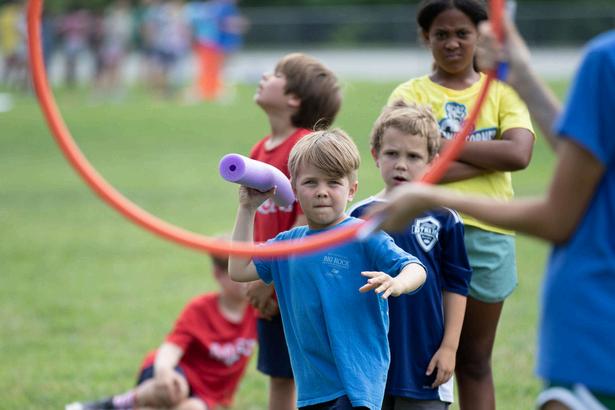
Overview
Community input was central to the development of the Hanover County Parks and Recreation Master Plan. Feedback was gathered through online surveys, community meetings, stakeholder discussions, and direct comments from residents. This inclusive process provided both countywide perspectives and community-specific insights, highlighting what residents value most while identifying gaps and opportunities to guide future improvements
Initial Survey
A countywide survey was conducted to better understand how residents use Hanover’s parks, their satisfaction with current facilities, and their priorities for the future This was one of the first components of the process that helped shape the plan development approach With 472 responses from a diverse cross-section of households, the survey offered critical insight into recreational needs, program interests, and facility expectations The results underscore the strengths of the existing system while pointing to areas for growth, serving as a foundation for recommendations that reflect the community’s needs and aspirations
Hanover County residents overwhelmingly agree on the value of a strong park system: High Value: 85.8% of respondents Strongly Agree that parks and open spaces should be important considerations in future land use decisions. Quality of Life: 84.7% Strongly Agree that a community’s quality of life is enhanced through a well-developed park system
Overall Enjoyment: 720% of respondents either Agree (487%) or Strongly Agree (233%) that the current parks and playgrounds are enjoyable to visit and use
Demographics and Location
Zip Codes: The largest number of responses came from zip codes 23116 (367%) and 23111 (309%)
Age: The primary age group of respondents is 35 - 44 years old (41%), followed by the 2534 and 45 - 54 age brackets (both at 16%).
Willingness to Travel: A majority of respondents (60.8%) are willing to travel 10 to 19 minutes (30.3% for 10-14 min; 30.5% for 15-19 min) to participate in Parks and Recreation activities.
Top Desired New Facilities and Activities
The highest priority facilities that respondents wish to see developed are listed below:
Recreation Center - 83.5%
Walking/Jogging/Biking Trails - 80.7%
Outdoor Community Swimming Pool - 79.0%
Picnic Areas - 70.6%
Playgrounds - 68.0%
Top Desired Future Activities
Archery - 28.6%
Walking/Hiking - 24.7%
General Fitness Classes - 23.9%
Facilities Requiring Improvement (Write-in Commentary)
Aquatics/Water Play: There is high demand for splash pads and indoor community swimming pools.
Athletic Fields: There is a strong desire for multi-sport synthetic turf fields due to current fields closing too frequently from inclement weather.
Pickleball: Existing courts at Pole Green Park are criticized for being low quality, lacking lights, and being overcrowded, leading players to seek better courts in other counties.
*Note: lighting was added to the pickleball courts at Pole Green Park in 2025
Disc Golf: The need for a dedicated, quality disc golf course in Hanover is a consistent, high-volume write-in request.
Playgrounds: Requests were made for more toddler-friendly and inclusive playground equipment.
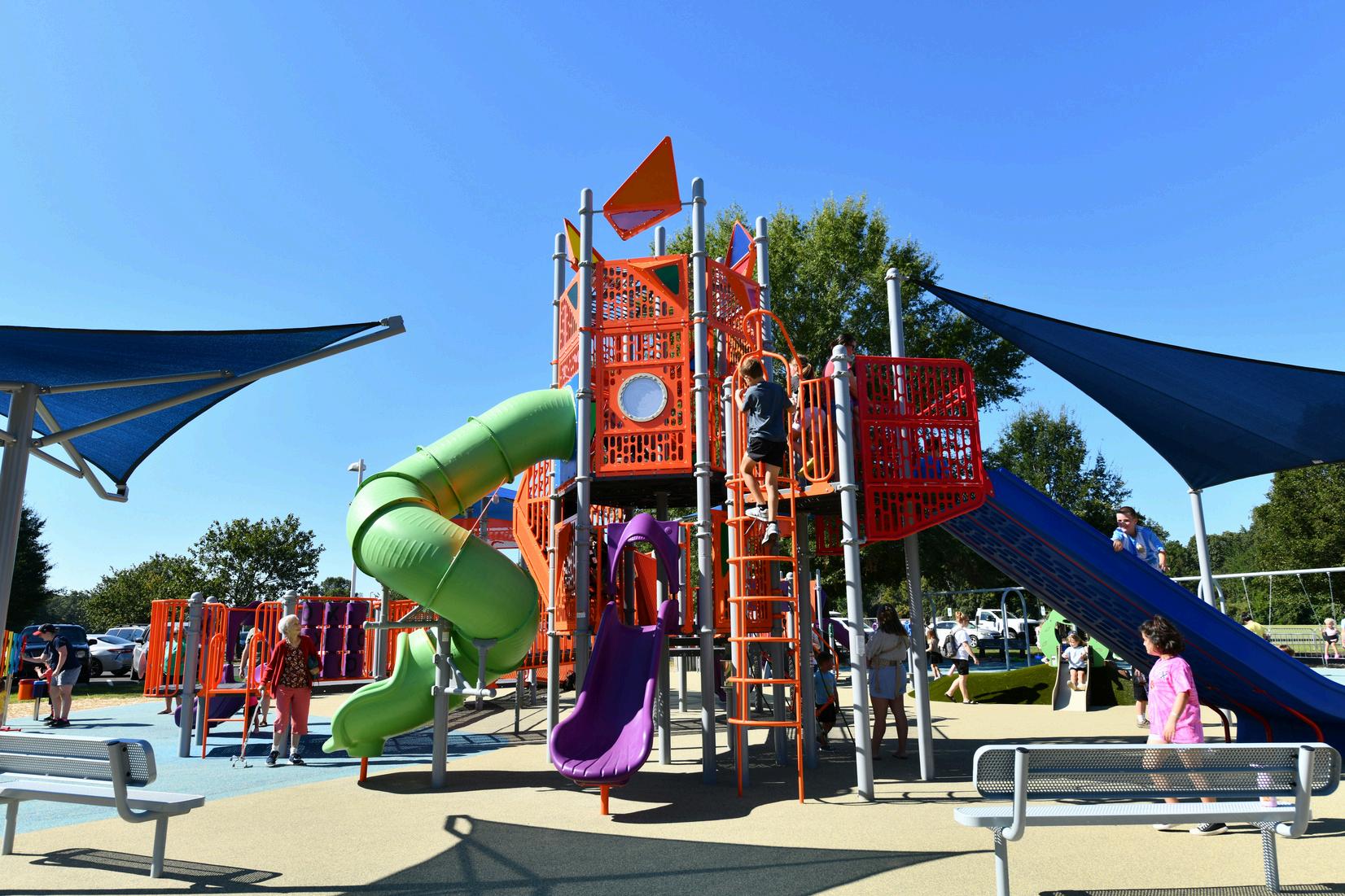
In addition to the initial survey, the department hosted public meetings in all seven magisterial districts, providing residents an opportunity to learn about current operations, ask questions, and share input for the master plan Each meeting featured visual display boards summarizing the department’s major functional areas and posing key questions for consideration. Participants recorded their ideas on adhesive notes and placed them directly on the boards, fostering a collaborative exchange of perspectives At the close of each meeting, all comments were reviewed, transcribed into a database, and organized for analysis. Across the process, more than 600 comments were collected, offering valuable insights to guide the development of the Parks and Recreation Master Plan.
Meeting Schedule and Locations
February 20 - Rural Point Elementary School (Henry District)
February 21 - Cool Spring Elementary School (Ashland District)
February 26 - South Anna Elementary School (South Anna District)
February 27 - Henry Clay Elementary School (Ashland District)
February 29 - Battlefield Park Elementary School (Cold Harbor District)
March 4 - Beaverdam Elementary School (Beaverdam District)
March 5 - Bell Creek Middle School (Mechanicsville District)
Note: Although located in the Ashland District, Cool Spring Elementary School was selected as the most central and accessible public meeting location for residents of the Chickahominy District
Several core themes were quickly identified during the evaluation of public meeting comments. These themes are summarized below.
A major theme is the demand for a more comprehensive trail network, focusing on passive recreation like walking, hiking, and biking There is a clear desire to establish feeder trails and trailheads that connect existing parks and neighborhoods to the regionally significant Fall Line Trail Additionally, there are numerous requests for developing more mountain bike trails and improving the safety and maintenance of all trail systems to enhance the county's overall walkability
Athletic Facilities
There was clear interest in a range of new or enhanced athletic facilities.
Traditional Facilities
Respondents highlighted athletic facilities as a key focus, citing the need for new fields to support traditional and growing athletic programs. The addition of synthetic turf playing fields was a frequent request, as they would allow for year-round play with less downtime due to inclement weather, an amenity already available in neighboring communities.
Disc Golf
Comments highlighted that Hanover County is the only large county in Central Virginia lacking a public disc golf course. Proponents stressed the sport's low cost of construction and ongoing maintenance, in addition to its broad appeal, ease of entry, and potential for generating sports tourism revenue.
Pickleball
Many respondents cited the urgent need to expand and upgrade existing pickleball facilities, with a clear desire for more courts, particularly in the Ashland and Western Hanover areas. A frequent demand was for higher quality courts, as many pointed to the slope and poor craftsmanship of the current courts at Pole Green Park. Other necessary amenities cited were lighting for nighttime use and restrooms near the playing area.
Cricket
Responses indicate a growing local population of cricket enthusiasts is driving the request for dedicated cricket facilities There is clear demand for these amenities in the Atlee and Ashland areas where the playing community is most concentrated
Water Access and Amenities
There was clear demand for increased public access to the county’s natural water resources Specifically, requests were made for more access points on the Pamunkey, North Anna, South Anna, and Chickahominy Rivers for kayaking and fishing Respondents also requested the development of park land to include ponds and small lakes for fishing opportunities
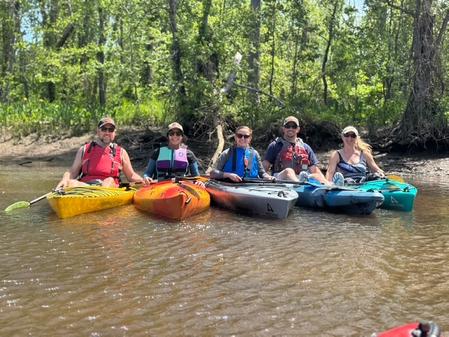
The request for Splash Pads and Aquatic Play Areas is driven by the need for accessible, local water recreation that families with young children currently lack. The primary plea is to stop the necessity of driving to neighboring counties for this simple summer amenity, with many residents identifying areas like Pole Green Park and Hanover Wayside Park as ideal locations for installation. These features are seen as a cost-effective alternative to building full pools and are considered a must-have to attract and retain young families in the community. Furthermore, these aquatic play areas are championed for their ability to be incorporated into smaller, existing spaces in mature neighborhoods that currently have few park amenities
The feedback regarding playgrounds centers on improving both the quantity and inclusivity of existing and future facilities A highly specific and emotional request is the need to reintroduce baby and toddler swings, as their removal or replacement with only accessible swings is forcing families with infants to travel outside the county More broadly, there is a strong, unified demand for the county to build an all-abilities park or playground that is fully inclusive and accessible to children in wheelchairs and those with disabilities Beyond accessibility, residents ask for the renovation and expansion of current playgrounds, incorporating modern, imaginative designs with features like sensory equipment and innovative structures built into natural hills.
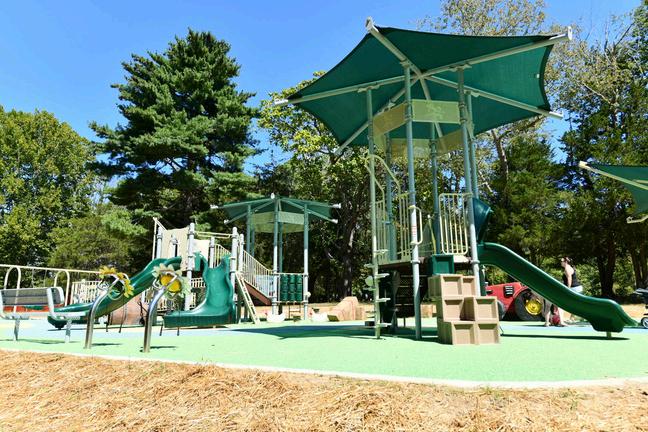
A gap analysis is an essential tool for evaluating how well Hanover County’s parks and recreation system meets the needs of its residents compared to nationally recognized benchmarks and community expectations By examining current parkland, facilities, staffing, and funding alongside NRPA standards and best practices, the analysis highlights where the county is adequately resourced and where shortfalls exist This process is important because it provides a clear, evidence-based understanding of the difference between existing resources and what is required to support a growing and diverse population Identifying these gaps not only validates concerns raised by residents during the community engagement process but also helps prioritize future investments in land acquisition, facility development, staffing, and operating support Ultimately, the gap analysis serves as a roadmap for aligning Hanover’s parks and recreation system with both national standards and local demand, ensuring that services remain equitable, sustainable, and responsive to community needs.
Hanover County currently provides approximately 61 acres of parkland per 1,000 residents, which is below the NRPA median benchmark of 10 acres per 1,000 This shortfall represents a deficit of more than 443 acres based on the county’s population of 115,309 While Hanover has invested in traditional park sites and regional parks, continued growth is placing added pressure on available parkland It is important to note that Washington Lacy Park is the only park located within the Suburban Services Area No public parks exist in the Mechanicsville and Atlee areas, which are both densely populated. Expanding the supply of parks, particularly in underserved areas, will be essential to ensuring equitable access and meeting future demand.
Community feedback and usage data consistently point to a shortage of athletic fields to support youth and adult sports. NRPA benchmarks suggest Hanover should provide approximately 16 diamond fields and 12 rectangular fields The County’s park system offers 11 diamonds and 23 rectangular fields These existing resources are regularly scheduled to capacity, especially at Pole Green Park and Courthouse Park The department relies heavily on diamond practice fields located at elementary school sites The department has access to three fields: two at Cold Harbor Elementary School and one at Rural Point Elementary School In the last several years, five practice fields have been lost due to school reconstruction efforts Future park development should include considerations for athletic facilities based on community demand, which exceeds NRPA benchmarks
Hanover’s system includes only one recreation center, which is below the 4–6 centers typically found in communities of similar size, and two small, aging community buildings. Recreation centers are critical for providing indoor space for fitness, arts, community programs, and yearround activities, particularly during inclement weather. The lack of adequate indoor facilities was also highlighted during community engagement, with strong interest expressed in additional spaces for fitness, pickleball, aquatics, and multipurpose programming. Expanding the county’s inventory of recreation centers would help fill this gap and respond directly to resident demand
With 34 full-time equivalent staff, Hanover provides about 30 FTEs per 10,000 residents, far below the NRPA benchmark of 70–105 FTEs This equates to a staffing deficit of 45 to 85 positions compared to national standards While Hanover staff are highly regarded by the community for their professionalism and dedication, the limited number of personnel constrains the county’s ability to expand programming, maintain facilities at a high level, and support new parks or amenities. Addressing this gap will be critical to sustaining service quality as demand increases.
Hanover invests about $48.50 per resident annually in parks and recreation operations, which is significantly below the NRPA benchmark range of $90 to $120 per resident. This represents an annual shortfall of more than $44 million when compared to national averages While the county has been efficient in managing available resources, the funding gap limits the ability to expand programs, increase staffing, and enhance facilities To keep pace with community expectations and growth, increased investment in operations and capital investment will be necessary to strengthen Hanover’s overall service capacity
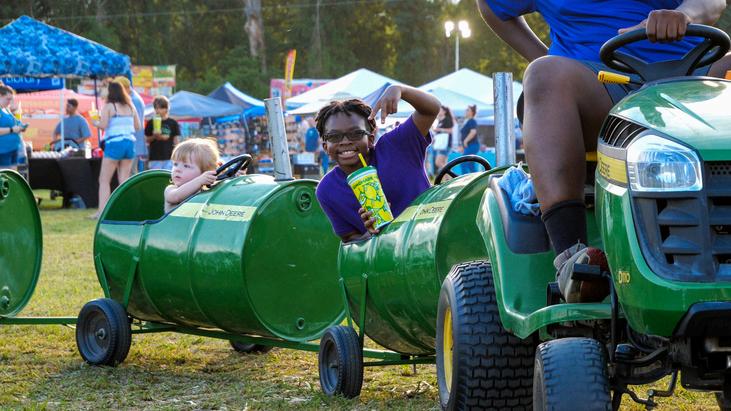


Understanding the Suburban Services Area
Hanover County’s Suburban Services Area (SSA) is the portion of the county where public infrastructure, such as water, sewer, and transportation systems, is planned and provided to support higher-density residential, commercial, and industrial development. The SSA serves as a growth management tool that directs development to areas best equipped to accommodate it, allowing the county to promote efficient land use, reduce sprawl, and preserve the rural character and open spaces outside its boundaries.
Within the SSA, Washington Lacy Park is currently the only publicly accessible county park with Pole Green Park and Hanover Wayside Park sitting just outside of the boundary of the SSA Many subdivisions in this area include private recreational amenities such as playgrounds, pools, trails, open space, and community buildings as required by County planning standards, but these facilities vary widely in scope, quality, and management practices Importantly, such private facilities are not a substitute for public parks, as they are generally restricted to neighborhood residents and cannot accommodate activities that serve the broader public
To address this imbalance, Hanover County should prioritize developing small parcels within the SSA into neighborhood parks that provide accessible recreation opportunities for nearby residents. These smaller parks can enhance quality of life in older suburban areas that predate current recreation requirements and may lack convenient public green space. At the same time, the county should remain open to pursuing opportunities for a larger community or regional park within the SSA if appropriate land becomes available, ensuring long-term equity and inclusivity in access to recreation for all residents.


Understanding the trends shaping parks and recreation services at the national, state, and local levels is critical to ensuring Hanover County Parks and Recreation remains responsive to community needs These trends provide insight into how recreation patterns are evolving, what residents expect, and where investment will have the greatest impact By aligning Hanover’s resources with these guiding principles, the County can sustain its strong foundation while preparing for growth, emerging interests, and changing demographics
Across the nation, organized youth and adult sports continue to grow, and Hanover reflects this trend with strong participation in baseball, softball, soccer, and other field-based sports. The County’s proximity to schools places added pressure on shared facilities, highlighting the need for more athletic fields to reduce scheduling conflicts and ensure equitable access. Investments in field capacity and maintenance will be critical to meeting demand
Pickleball is one of the fastest-growing recreational activities in the United States, and Hanover residents have reflected this trend by requesting more courts To meet this demand, the County will need to develop dedicated facilities that are appropriately distributed across the community The department should also plan for the programmatic evolution of pickleball, as it shifts from informal open play toward more structured leagues and competitions comparable to traditional sports programs
National and state data show that trails are the most desired recreation amenity. Hanover residents also expressed strong interest in walking, biking, and nature trails as safe, accessible options for health and wellness. Expanding Hanover’s trail system, linking parks to neighborhoods, and providing opportunities for mountain biking will enhance connectivity, promote active lifestyles, and support eco-tourism.
Trends highlight growing demand for splash pads, spray parks, and natural water access as family-friendly recreation opportunities Hanover residents specifically cited splash pads as a desired amenity, which would add variety to the system and serve younger children while providing relief in summer months Improving access to the South Anna, North Anna, Pamunkey, and Little Rivers also reflects national interest in blueway recreation
Across comparable communities, indoor recreation centers are increasingly essential for yearround programming, fitness, and community gathering. Hanover currently has limited indoor space, which restricts its ability to expand adult fitness, arts, and social programs. Investment in new or expanded indoor facilities would align Hanover with peer jurisdictions and directly respond to community demand.
Nationally, recreation agencies are prioritizing equitable access and inclusive programming that meets the needs of residents of all ages, backgrounds, and abilities Hanover has already demonstrated leadership through its adaptive recreation programs and should continue to expand opportunities that reflect the County’s changing demographics, including programs for older adults and diverse cultural offerings through the Hanover Museum of History and Culture
Accessibility is a growing priority in parks and recreation, ensuring that facilities, programs, and services are usable by residents of all abilities. National trends emphasize universal design in parks, playgrounds, and trails, as well as expanded adaptive recreation opportunities. For Hanover, improving accessibility means not only meeting ADA requirements but also proactively designing inclusive spaces such as playgrounds with sensory-friendly features, accessible trails, and program adaptations that allow everyone to participate fully.
Parks and recreation master plans are typically guided by a set of principles that ensure they reflect community values, meet current and future needs, and remain financially and environmentally sustainable
Principle
The plan should reflect the needs, priorities, and aspirations of the community it serves.
Equal Access
Principle
Ensure all residents regardless of age, ability, income, or background have access to quality parks and recreation opportunities.
Principle
Protect and enhance natural, cultural, and historical resources for future generations
5.2
Connectivity
Principle
Parks and recreation should be interconnected with trails, sidewalks, greenways, and transit.
Partnerships and Collaboration
Principle:
Leverage partnerships with schools, nonprofits, civic groups, and private organizations to expand opportunities.
Flexibility and Adaptability
Principle
Recognize that recreation trends change over time (eg, rise of pickleball, demand for outdoor fitness)
Health and Wellness
Principle
Parks and recreation are essential to physical, mental, and social health
Quality and Safety
Principle
Facilities and programs must meet high standards of design, maintenance, and accessibility.
Conclusion
The guiding trends and principles presented in this chapter underscore the dynamic nature of parks and recreation and the need for Hanover County to adapt in order to remain responsive to its residents From athletic fields to pickleball courts, trails to splash pads, and indoor facilities to inclusive programming, the community’s feedback aligns closely with national and state trends Addressing these priorities will require strategic investment in land, facilities, personnel, and partnerships By embracing these guiding principles, Hanover County Parks and Recreation can position itself to meet current needs while building a resilient, forwardlooking system that enriches the quality of life for all residents.
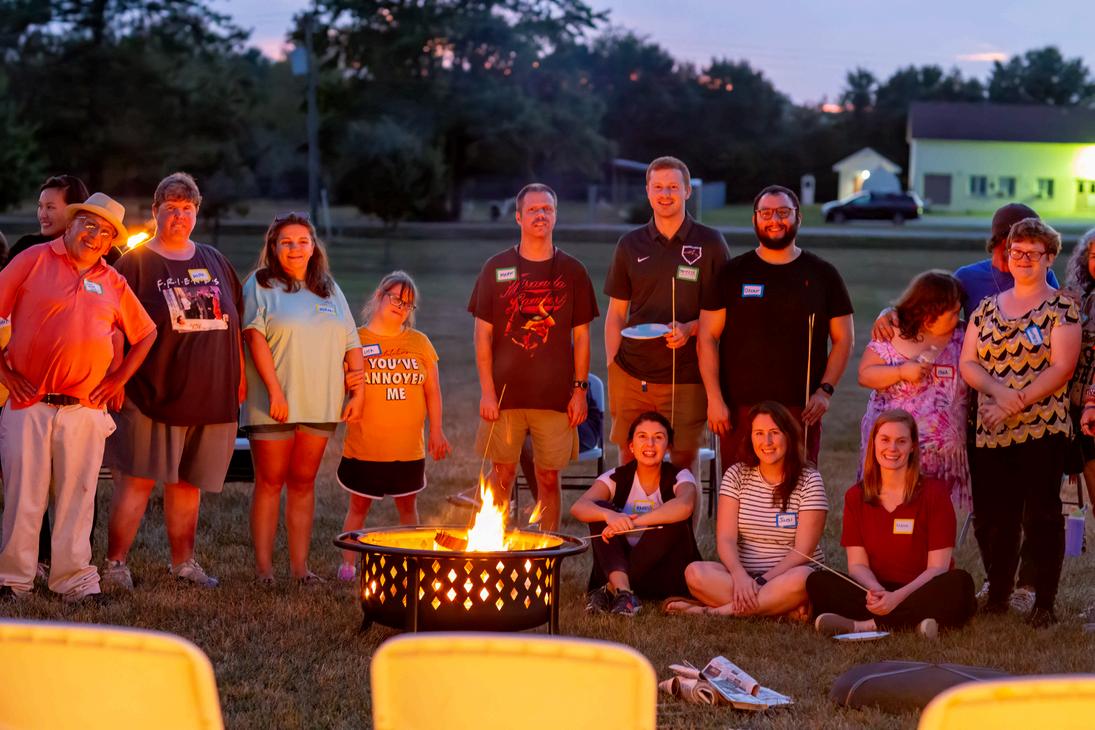
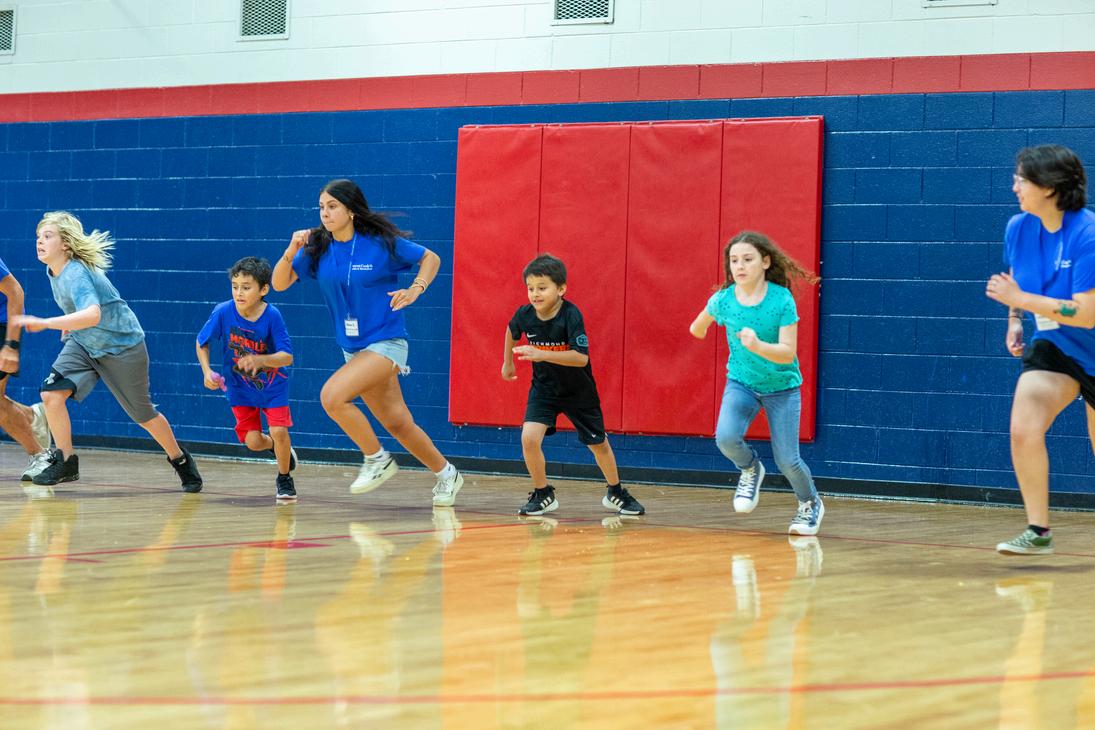
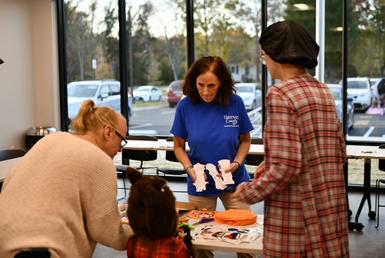

The implementation chapter translates the vision, goals, and guiding principles of this Master Plan into clear, actionable steps for Hanover County. While the preceding chapters identify community needs, system gaps, and future opportunities, implementation focuses on how these priorities can be achieved through phased park expansion, facility improvements, staffing and operational growth, and sustainable budget planning This chapter provides a roadmap that balances ambition with fiscal responsibility, ensuring that investments are strategic, equitable, and adaptable to changing conditions By aligning resources, partnerships, and timelines, the implementation plan offers a practical framework to guide decision-making and move the County toward its long-term vision for a connected, inclusive, and resilient parks and recreation system
Implementing park expansion plans requires a coordinated approach that balances community needs, financial resources, and long-term stewardship In Hanover County, this process involves identifying priority areas for new parks and facilities, securing funding through a combination of public investment and potential partnerships, and ensuring that each project aligns with the County’s Comprehensive Plan and Parks and Recreation Master Plan Careful consideration is given to site selection, environmental impact, and equitable access, with the goal of expanding opportunities for recreation while preserving natural and cultural resources By phasing projects strategically and engaging residents throughout the process, Hanover County can ensure that park expansion efforts are sustainable, responsive, and supportive of the community’s quality of life for years to come
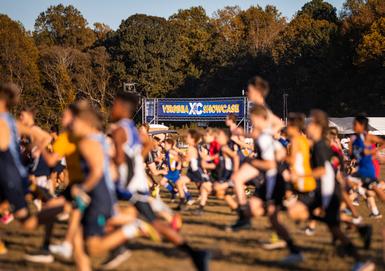
Strategy:
Develop 3-6 neighborhood parks to serve densely populated areas

Development of neighborhood parks, typically on parcels sized 1-20 acres, should be focused primarily in the Suburban Services Area. The SSA represents the County’s most densely populated areas where access to public green space is limited. This is particularly true in the Atlee, Elmont, and Mechanicsville areas.
These parks will often include playgrounds, short walking trails, picnic facilities, and open space They may include amenities like basketball or pickleball courts, depending on the size of the parcel available
The timing of park development is heavily contingent on funding availability and land acquisition opportunities The proposed strategy of 3-6 parks in the next 10 years will help the county align more closely with national benchmarking while providing needed recreational opportunities in older suburban communities
6.2 Park Expansion (continued)
Strategy:
Develop 1-3 community parks to meet community needs

Community parks, typically ranging from 20 to 99 acres, play a vital role in Hanover County by providing residents with versatile spaces for recreation, social gatherings, and outdoor activities Currently, the County has only three community parks, limiting opportunities for many residents to access facilities such as sports fields, playgrounds, picnic areas, and walking trails within a reasonable distance Expanding the number of community parks would help meet growing recreational demands, promote active lifestyles, and strengthen neighborhood connections
The development of community parks would focus on the Cold Harbor, South Anna, and Beaverdam districts, providing recreational opportunities where service gaps currently exist. A community park in the South Anna District could be linked to or serve as an access point to the newly opened Fall Line Trail.
Developing a regional park in the eastern or central portion of Hanover County would provide critical recreational access to the County’s most densely populated areas While the County currently has a satisfactory amount of regional park acreage according to national benchmarks, albeit on the lower end of the recommended range, adding an additional park of 100 acres or more would create opportunities for high-quality athletic facilities, expanded sports tourism, and additional field space to support local leagues and community groups. It would also allow for the inclusion of amenities that support passive and specialized recreational pursuits, enhancing overall park experiences. However, due to the significant funding requirements and challenges associated with land acquisition, the implementation of a new regional park is most realistically considered as part of a 20-year outlook for Hanover County
Strategy:
Begin site search and feasibility review for the addition of one regional park with high-quality athletic facilities, support facilities, and capacity for large crowds
The development of specialty park sites in Hanover County over the next 10 years is expected to be largely opportunistic, guided by the desire to conserve natural resources or preserve historic and cultural assets. While these sites typically offer a more limited range of recreational activities and are not included in national park benchmarking standards, they play a crucial role in the overall park system. Specialty parks contribute to the protection of valuable natural landscapes, sensitive ecosystems, and historically significant sites, ensuring that unique environmental and cultural resources are maintained for future generations. In doing so, they enhance the diversity and functionality of the County’s park system beyond traditional recreational uses.
Strategy:
Identify natural and cultural resources that would benefit from conservation or preservation efforts
Hanover County’s growing population and evolving recreation needs highlight the importance of expanding indoor recreation opportunities beyond the County’s only existing recreation center, the Montpelier Recreation Center and Library in western Hanover While this facility provides a valuable resource with a gymnasium and classroom space, it cannot adequately serve residents across the entire county. Indoor recreation facilities play an essential role in providing year-round access to fitness, wellness, youth activities, and community programming. Without additional centers, many residents particularly those in central and eastern Hanover face limited access to indoor recreation opportunities that support health, community connection, and quality of life.
Recognizing this need, Hanover County has already identified an eastern Hanover recreation center in its 25-year Capital Improvement Plan The development of this facility will require careful planning to ensure that it reflects community priorities and provides a flexible range of amenities Strong community engagement will be critical in shaping the design, focusing on spaces such as indoor play areas, fitness equipment, classrooms, and multi-use community rooms In addition, the County should evaluate opportunities to repurpose existing buildings, such as former schools, to reduce costs and maximize the use of existing infrastructure This approach balances fiscal responsibility with responsiveness to community needs
Looking ahead, planning for a centrally located recreation center should also be considered within the 20-year outlook. When mapped using a 10-mile service radius, a combination of eastern and central recreation centers would provide access to indoor recreation opportunities for over 95% of Hanover’s population. By strategically locating facilities and carefully weighing new construction against the repurposing of existing sites, Hanover County can ensure that residents across all regions benefit from accessible, modern indoor recreation options. This forward-looking approach will position the County to meet both current and future needs, while reinforcing its commitment to community health, wellness, and engagement
Strategy:
Plan and develop an eastern Hanover recreation center within the next 10 years
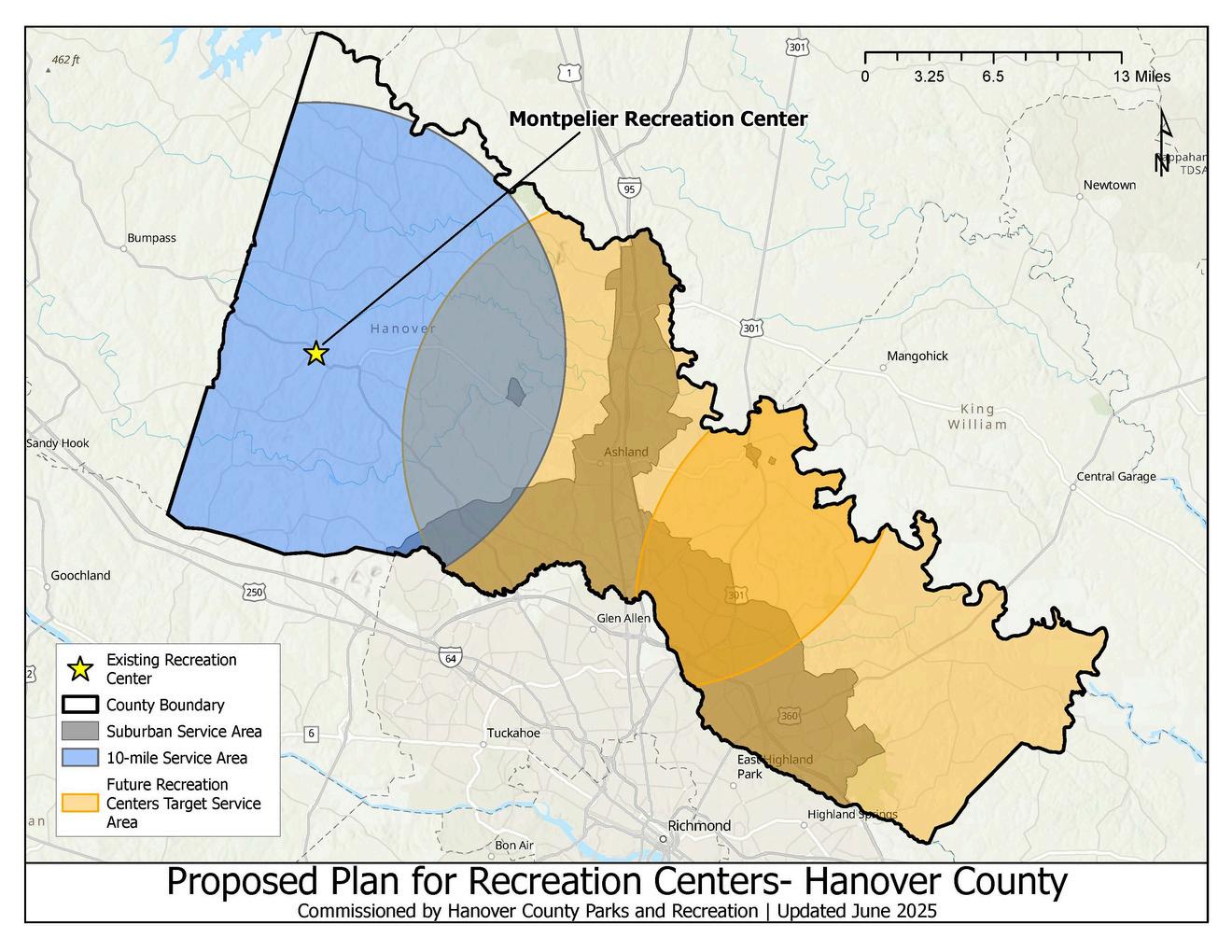
The map above demonstrates the service area coverage if both an eastern Hanover and central Hanover recreation center were developed The service areas were created using a 10mile service radius A 10-mile service radius is used as a practical benchmark for indoor recreation facilities because it reflects a reasonable 15–20-minute drive time in a suburbanrural county, aligns with NRPA and peer-county standards, and provides a consistent measure for evaluating equitable access and planning future facility investments The eastern service area was established by focusing on an area east of Interstate 295 and along the Route 360 corridor The central service area was established by focusing on an area near the intersection of Interstate 95 and State Route 54 Developing recreation centers based on these two service areas will ensure accessibility to 95% of Hanover County residents
Parks
Many of Hanover County’s park facilities have served residents for decades, providing valuable recreational opportunities and community gathering spaces However, as infrastructure ages and recreational preferences evolve, it becomes increasingly important to develop intentional strategies for improving existing park spaces A strategic, systemwide approach ensures that facility upgrades are guided by data, community input, and long-term priorities rather than short-term fixes. By identifying specific needs at each site, ranging from structural repairs to modernization opportunities, the County can extend the lifespan of its assets, enhance functionality, and maintain the overall quality and appeal of the park system.
Accessibility and safety are foundational components of these improvement strategies. As facilities are upgraded, attention to ADA compliance, universal design principles, and safe circulation patterns will help ensure that all residents, regardless of age or ability, can comfortably and confidently enjoy their parks. Addressing deferred maintenance, replacing outdated infrastructure, and incorporating modern lighting, surfacing, and signage will improve both user safety and operational efficiency These improvements not only reduce long-term maintenance costs but also build community trust by demonstrating a continued commitment to well-maintained, welcoming public spaces
Environmental sustainability must also guide the reinvestment process By integrating sustainable design practices, such as the use of native landscaping, green infrastructure, energy-efficient materials, and low-impact development techniques, Hanover County can protect natural resources while reducing operational costs Enhancing tree canopy coverage, improving stormwater management, and restoring natural habitats will make parks more resilient to changing environmental conditions. Together, these strategies will ensure that Hanover’s existing parks remain safe, inclusive, and environmentally responsible spaces that meet the recreational needs of current and future generations.
Specific strategies for each park space are outlined in the following section.
Parks
Courthouse Park Key Strategies
1-3 years
Improve condition of parking areas throughout; expand parking where applicable
Improve wayfinding and regulatory signage
Improve landscaping
3-5 years
Develop permanent restrooms to serve multipurpose fields 1-3 and hockey rink
Upgrade existing restrooms and concession space
Relocate play area to maximize natural shade and improve accessibility
Improve athletic fields to address grading, drainage, and turf quality
5-10 years
Expand trail network to utilize wooded area of park; link both sides of park with formal crosswalks and interconnected trail system
Examine feasibility of additional athletic facilities and synthetic turf surfacing
Examine feasibility of roofing and upgraded lighting for hockey rink
Examine feasibility for dedicated right turn lane for exiting traffic
Hanover Wayside Park Key Strategies
1-3 years
Develop permanent restroom easily accessible from playground and picnic shelters
Improve wayfinding and regulatory signage throughout
Improve landscaping
Improve trail network by establishing a main loop around the park and addressing issues with erosion
3-5 years
Update picnic shelters to improve user experience
Install interpretive signage to celebrate the rich history of this park space as one of the few remaining Works Progress Administration Recreation Demonstration Area
5-10 years
Improve parking and accessibility throughout
Replace playground with nature-inspired accessible play system to serve children of all abilities
Improve lighting for safety and security
Parks
Montpelier Park Key Strategies 1-3 years
Improve gravel parking areas and address concerns with stormwater management
Improve wayfinding and regulatory signage
Improve landscaping
3-5 years
Explore feasibility of addition of a dog park
Improve trail system throughout park space, connecting pedestrian infrastructure from new facilities with existing park trail network; improve and expand nature trail area
Improve existing athletic facilities to support youth and adult athletic activities
5-10 years
Renovate Ruritan building to better support civic functions
Explore feasibility of aquatic play area
Replace playground with fully accessible play system that provides recreational opportunities for children of all abilities
Pole Green Park Key Strategies 1-3 years
Add pickleball courts to meet growing needs
Improve existing restrooms
Improve trails and establish trailheads; create paved trail loop throughout park
Improve wayfinding and regulatory signage; improve landscaping
Improve existing maintenance facilities
Improve existing parking areas; expand parking where feasible
3-5 years
Improve athletic facilities to address grading, drainage, and turf quality
Improve athletic spectator areas
Improve cross country facilities to better support large sports tourism opportunities
Add aquatic play area
Renovate dog park area
5-10 years
Renovate skate park
Explore feasibility of athletic improvements and additions including basketball courts, futsal courts, synthetic turf fields, disc golf course, and new press box
Parks
Poor Farm Park Key Strategies
1-3 years
Improve gravel parking areas and expand parking capacity to better support sports tourism opportunities and local athletic leagues
Improve trail system throughout park space to better accommodate mountain biking activities as well as hikers and runners; establish paved shared use path that connects major activity nodes
Improve wayfinding and regulatory signage throughout; improve landscaping
Improve existing maintenance facilities
Replace existing restroom/concession facilities
Add pickleball courts
3-5 years
Improve existing athletic facilities
Improve spectator areas
Add permanent restrooms to support playground area and multipurpose fields 7-9
Add aquatic play area
Add interpretive signage to celebrate rich history of the property
5-10 years
Explore feasibility of synthetic turf athletic facilities
Explore feasibility of creating a destination for mountain biking events and competitions to drive sports tourism opportunities
Taylor Park Key Strategies
1-3 years
Add pickleball courts
Improve wayfinding and regulatory signage; improve landscaping
3-5 years
Improve athletic facilities to address grading, drainage, and turf quality
Add restroom facility
Renovate dog park
5-10 years
Renovate maintenance facilities
Explore feasibility of recreation center or additional athletic facilities
Specialty Sites
Cold Harbor and North Anna Battlefield Park Key Strategies
Improve wayfinding, regulatory, and interpretive signage
Improve parking areas and accessibility
Improve interpretive elements and landscaping
Explore feasibility of trail expansion; improve overall trail accessibility
Henry Clay Ballfields Key Strategies
Improve athletic facilities to address grading, drainage, turf quality, fencing, and overall user safety to support local youth athletic programming
Improve spectator areas
Improve restroom facilities
Improve overall facility accessibility
Replace picnic shelter
Improve wayfinding and regulatory signage throughout
Lake Hanover Nature Trail Key Strategies
Improve wayfinding, regulatory, and interpretive signage
Improve landscaping
Improve overall facility accessibility
Explore feasibility of establishing a larger conservation area that encompasses the existing trail and protects the entirety of the wetland area
Explore the feasibility of the wetland boardwalk to improve environmental education, birding, and nature viewing opportunities
Washington Lacy Park Key Strategies
Improve trail system for walking, biking, and equestrian u
Improve parking area
Improve wayfinding and regulatory signage throughout
Improve landscaping
Replace picnic shelter
Add playground
Add disc golf course
Add restroom facility
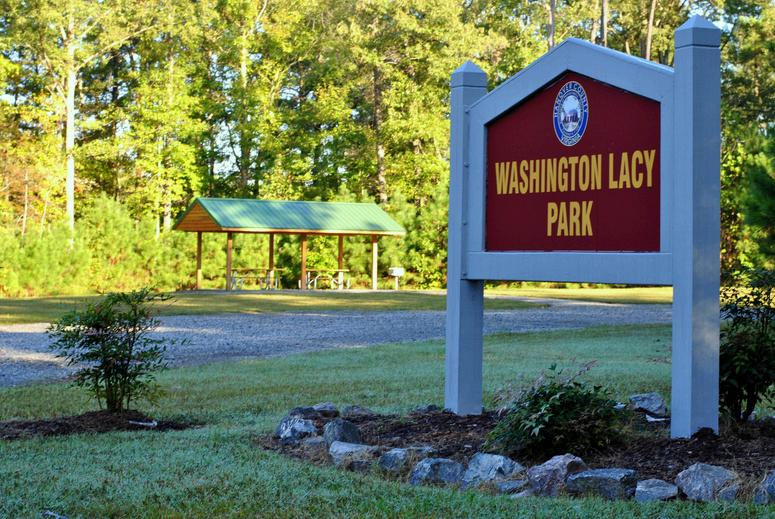
6.4
Undeveloped Sites
Chickahominy Park Key Strategies
Improve existing trail network
Add environmental interpretation signage for Totopotomoy Creek
Explore feasibility of playground
Explore feasibility of off-street parking
Explore feasibility of stream restoration
Little River Key Strategies
Establish site as a formal conservation area
Explore feasibility of expansion
Explore feasibility of parking facilities
Explore feasibility of trail network
Explore feasibility of environmental education opportunities
Explore feasibility of historic preservation of stone mill ruins
Winding Brook Site Key Strategies
Explore feasibility of greenway trail system
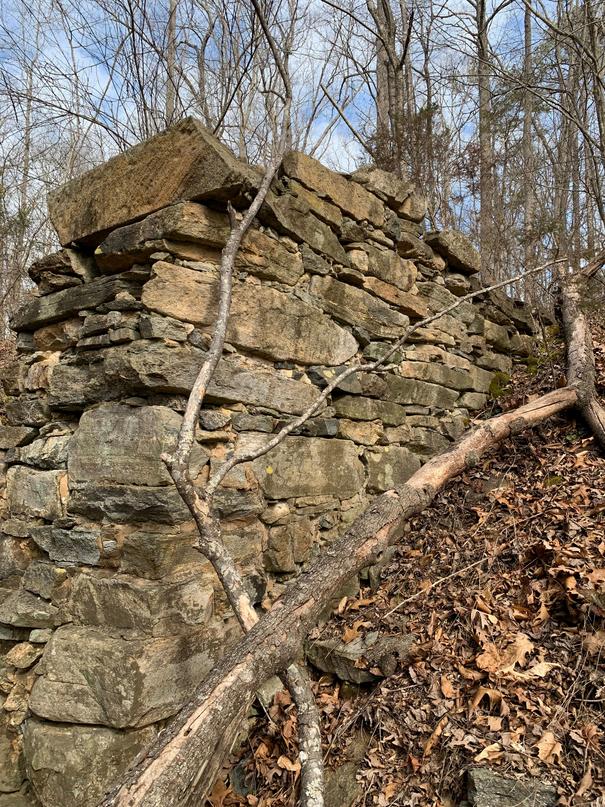

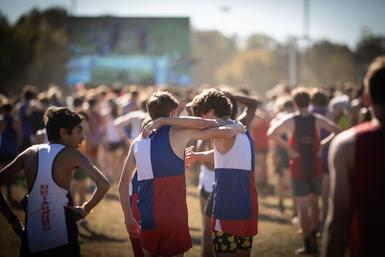
Staffing
As Hanover County continues to grow, the Parks and Recreation Department will require expanded staffing resources to meet the increasing demand for facility maintenance, program delivery, and community services. Current staffing levels 34 full-time employees supported by part-time and seasonal staff are stretched across a variety of park sites and government facilities, and a year-round calendar of programs and events To sustain quality service and align with national benchmarks, Hanover must invest in personnel growth that supports both daily operations and long-term system expansion
Strategy:
Invest in personnel growth to meet the current needs of the community and ensure that growth is commensurate with the addition of parks, facilities, and new programming
Highest Priority Positions
Media Specialist
Groundskeeper
Park Planner
Trails/Resources Manager
Trails Specialist
Recreation Manager
Recreation Coordinator
Customer Service Agent
Sports Tourism
Hanover County’s strategic location, high-quality athletic complexes, and strong demand for tournament play position it well to expand sports tourism as both a community and economic driver By investing in upgrades to existing facilities, pursuing the development of clustered multipurpose fields, and strengthening partnerships with local leagues, regional tourism agencies, and private organizations, Hanover can establish itself as a premier tournament destination while maintaining equitable access for residents Expanding amenities such as concessions, restrooms, parking, and spectator spaces will enhance the visitor experience, while clear scheduling policies will ensure community use remains a priority
Strategy:
Work closely with the newly formed Tourism Department to plan future facilities, develop tourism and scheduling policies, and strategically pursue sports tourism events
(continued)
Hanover County should strengthen partnerships with schools, civic organizations, sports associations, volunteer groups, and private providers to maximize the use of existing recreation facilities and to expand programmatic opportunities Formal joint-use agreements with Hanover County Public Schools could expand public access to athletic fields and gymnasiums, while partnerships with entities like Sportable could expand adaptive recreation programming and indoor recreation opportunities In addition, targeted collaboration with local sports organizations and regional tourism entities will help Hanover expand its role as a sports tourism destination, attracting tournaments and events that generate economic impact while ensuring that local user groups continue to benefit from these enhanced facilities
Strategy:
Identify strategic partnerships that will fill service gaps and expand recreational opportunities for the community
Hanover County holds a rich legacy of historic sites and cultural resources that are vital to both community identity and tourism To protect and celebrate this heritage, the County should adopt a historic and cultural preservation strategy that integrates preservation into the broader parks and recreation system This includes protecting significant battlefields and cultural landscapes through land acquisition, stewardship opportunities, and educational programming. The Hanover Museum of History and Culture will play a pivotal role in uniting local historical societies, museums, and state and federal preservation agencies to foster collaborative efforts. By weaving historic and cultural preservation into park planning, Hanover can both safeguard its unique heritage and expand its tourism and educational offerings.
Strategy:
Identify history work collaboratively n
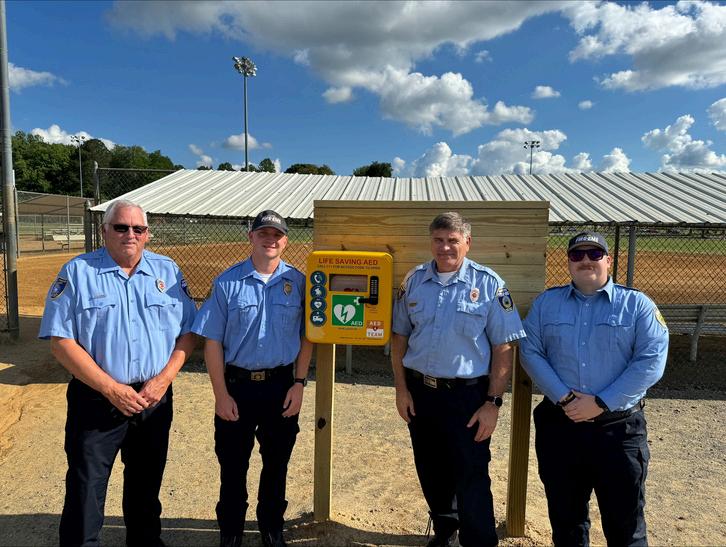
To ensure that Hanover’s parks and recreation system continues to evolve with the community, the County should pursue a recreational programming strategy rooted in ongoing needs assessment and responsive planning Regular evaluation of community preferences through surveys, program participation data, and public engagement will guide decisions about which programs to expand, adapt, or retire Strategic partnerships with schools, local nonprofits, sports associations, and private providers will enhance program offerings while leveraging shared resources and expertise
A critical element of this strategy is the establishment of clear cost recovery goals and program policies to guide decision-making. By classifying programs based on their community benefit (e.g., essential services, enhanced programs, or specialty services), Hanover can align fees, subsidies, and resource allocation with policy objectives. This approach ensures that core community programs remain affordable and accessible to all residents, while more specialized offerings incorporate appropriate cost recovery to promote long-term financial sustainability.
Strategy:
Develop a recreational programming strategy with an emphasis on assessment, partnerships, cost recovery, and policy
Hanover County should pursue a comprehensive environmental stewardship strategy that embeds sustainability into all aspects of its parks and recreation system This approach should focus on energy efficiency, land conservation, and best practices in sustainable design and operations New facilities should incorporate high-performance building standards, such as energy-efficient lighting, HVAC systems, and renewable energy sources where feasible
Park maintenance practices should prioritize conservation, including sustainable landscaping, use of native plants, integrated pest management, and environmentally responsible stormwater management systems. By embedding environmental stewardship into both capital projects and day-to-day operations, Hanover can reduce its ecological footprint, model sustainable practices for the community, and protect the natural resources that are central to its identity and long-term quality of life
Develop environmental stewardship strategies that focus on energy efficiency, land conservation, and best practices in sustainability

The Hanover County 2035 Parks and Recreation Master Plan serves as a comprehensive roadmap to guide the County’s investment in recreation, culture, and community well-being. More than a catalog of projects, this plan reflects the voices of residents, the analysis of trends, and the evaluation of current conditions It affirms that parks and recreation are essential public services, not optional amenities, that directly shape the County’s quality of life, economic vitality, and long-term sustainability
Hanover’s parks are where children play, families gather, neighbors connect, and visitors discover the County’s unique history and natural beauty They are vital assets that require thoughtful stewardship and ongoing reinvestment This Master Plan acknowledges the challenges of uneven access, aging facilities, and growing demand, while also highlighting opportunities to expand trail networks, develop neighborhood parks, enhance indoor recreation, and celebrate the County’s historic and cultural heritage.
The Master Plan is organized around five core pillars, each representing a foundation for the next decade of progress:
Reinvest in aging infrastructure through targeted upgrades to athletic fields, playgrounds, and restrooms while introducing modern amenities such as inclusive play features, splash pads, and sustainable facility design Advance the development of the eastern Hanover recreation center and continue to explore innovative facility partnerships
Close service gaps by strategically acquiring land and developing neighborhood parks, expanding trail systems, and ensuring recreation opportunities are available across all magisterial districts.
Build a responsive programming model informed by ongoing needs assessments Establish clear cost recovery policies, maintain a balance between essential services and specialty programs, and strengthen offerings through partnerships with schools, nonprofits, and private providers
Protect battlefields, historic schools, and cultural landscapes while embedding sustainable practices into facility operations. Promote energy efficiency, green infrastructure, and conservation best practices to ensure that Hanover’s parks serve as models of environmental responsibility.
Partnerships and Regional Collaboration
Expand collaboration with Hanover County Public Schools, civic associations, sports leagues, and regional tourism entities These partnerships will maximize facility use, reduce duplication, and position Hanover as a regional hub for sports tourism and recreation
The benefits of investing in parks and recreation extend far beyond leisure Parks improve public health, reduce healthcare costs, and provide equitable spaces for social connection. Trails and greenways enhance mobility while strengthening the County’s environmental resilience. Recreational programs and cultural events build community pride and foster lifelong learning. Well-designed facilities contribute to property values, attract businesses, and support Hanover’s competitiveness within the Richmond metropolitan region.
For Hanover County, the role of parks and recreation is also deeply tied to identity. From Civil War battlefields to the Hanover Museum of History and Culture, from youth sports leagues to the Hanover Tomato Festival, these resources connect residents to both history and one another Parks and recreation are woven into the fabric of daily life and community memory, making their protection and enhancement essential to the County’s future prosperity


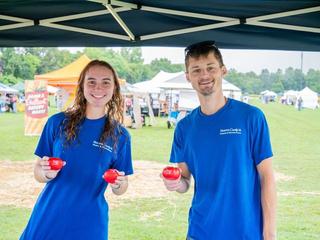
The Hanover 2035 Parks and Recreation Master Plan is a visionary yet practical strategy. It provides the County with a phased framework for addressing today’s most pressing needs while preparing for the challenges and opportunities of tomorrow. But the plan is only as strong as the commitment to implement it.
Hanover’s leaders, partners, and residents must embrace the following call to action:
Invest boldly in land, facilities, and programs that address community needs before opportunities are lost to rising costs or development pressures
Act strategically by phasing projects and prioritizing high-impact investments while leveraging regional partnerships
Engage continuously with residents to ensure that planning remains responsive, transparent, and reflective of community priorities.
Steward responsibly Hanover’s historic, cultural, and natural resources, protecting them for future generations while modeling sustainability.

By answering this call, Hanover County will not only enhance its parks and recreation system but will also reaffirm its identity as a community of health, connection, and heritage. This Master Plan establishes the framework what remains is the collective will to carry it forward Together, we can ensure that Hanover County remains a place where every resident has the opportunity to thrive, every visitor feels welcome, and every generation inherits a legacy of quality of life built on parks and recreation

The appendix of a Parks and Recreation Master Plan serves as a comprehensive reference section that supports and enhances the main body of the document. It provides detailed supplemental materials that inform the plan’s findings and recommendations. By housing these in the appendix, the plan remains focused and readable while still maintaining transparency and accessibility to the underlying research and engagement efforts that shaped its conclusions The appendix ensures that stakeholders, decision-makers, and the public have access to the full context and evidence base used throughout the planning process, reinforcing the plan’s credibility and data-driven approach
Benchmarking Hanover County’s parks and recreation resources against national standards and peer localities provides valuable context for understanding the county’s strengths and areas of need. These comparisons highlight how Hanover aligns with or diverges from typical measures such as park acreage per capita, recreation spending per resident, and staffing levels. Together, these metrics serve as a diagnostic tool, helping identify where the county is well-positioned to meet community demand such as in the amount of parkland available and where additional investment or resources may be necessary to support sustainable growth, equitable access, and high-quality service delivery
Benchmarking with National Recreation and Park Association (NRPA) standards is important because it provides a nationally recognized framework for evaluating the adequacy of parks, facilities, staffing, and funding These benchmarks allow communities like Hanover County to measure their resources against peer agencies of similar size and population, identify gaps in service, and prioritize areas for investment Using NRPA standards also strengthens planning efforts by aligning local decisions with best practices, ensuring that parks and recreation services remain equitable, efficient, and responsive to community needs.
Total park acreage is an important benchmark because it reflects the community’s overall access to open space and recreation opportunities Measuring acres per capita allows localities to compare their parkland supply to national standards and peer communities, helping determine whether current resources are sufficient to meet resident needs This benchmark also provides a foundation for planning, guiding decisions about land acquisition, facility development, and long-term investment to ensure that growing populations continue to have adequate space for play, exercise, and community gathering
Note: Park acreage and classifications used by the National Recreation and Park Association also align with recommendations provided by the Virginia Department of Conservation and Recreation in the Virginia Outdoors Plan For the purposes of benchmarking, NRPA figures will be referenced in this plan because they are based on a larger sampling of department metrics from across the nation.
Neighborhood parks play a vital role in the parks and recreation system by providing easily accessible spaces for play, exercise, and community gathering Neighborhood parks are often designed to target specific residential areas and are often within walking distance of densely populated areas These parks serve as the foundation of daily recreation opportunities, offering playgrounds, open fields, courts, and picnic areas that support both individual wellness and neighborhood connections Ensuring an adequate supply and distribution of neighborhood parks is essential to promoting active lifestyles, fostering community identity, and meeting the recreation needs of residents close to where they live
Community parks ranging in size from 20 to 100 acres are essential to a well-balanced park system because they provide the space and flexibility needed to serve diverse recreational needs at a community-wide scale These parks typically accommodate a blend of active and passive uses such as athletic fields, playgrounds, walking trails, open green spaces, and picnic areas allowing residents of all ages to gather, play, and engage in healthy outdoor activities Their size enables them to host both daily recreation and larger community events, offering a level of accessibility and service that smaller neighborhood parks cannot provide Additionally, community parks often serve as hubs for recreation programming and social interaction, strengthening community identity and promoting equitable access to quality outdoor spaces across broader geographic areas.
Regional parks are essential components of a balanced park system, offering large-scale facilities and natural areas that serve the entire county and beyond. Because they provide unique amenities such as athletic complexes, trail systems, water access, and space for tournaments or regional events, they require significantly more acreage than neighborhood or community parks Benchmarking regional park acreage helps ensure that Hanover can continue to meet the growing demand for countywide recreation opportunities and provide residents with access to destination-level facilities
Staffing levels are a critical benchmark in parks and recreation because personnel are the driving force behind facility operations, program delivery, and community engagement. Adequate staffing ensures that parks are well maintained, programs are accessible and diverse, and special events are safely and effectively managed. Comparing Hanover’s staffing levels to national benchmarks highlights the department’s current capacity while also identifying gaps that may limit the ability to expand services and meet the community’s growing recreation needs
Total operating expenditure is an important benchmark because it reflects the level of ongoing investment a community makes to sustain its parks and recreation system Unlike capital spending, which can fluctuate with major projects, operating expenditures capture the resources dedicated each year to staffing, maintenance, programming, and daily operations Comparing per capita operating costs to national standards and peer localities provides a clear measure of service capacity and financial commitment, helping identify whether current funding levels are sufficient to meet community expectations and support high-quality facilities and programs
Benchmarking Hanover County’s park system against NRPA standards highlights both strengths and areas of need that should guide the Parks and Recreation Master Plan
With 6 3 acres of parkland per 1,000 residents, Hanover falls below the NRPA median of 10 acres, underscoring the importance of continued land acquisition and development to keep pace with growth. Operating expenditures are also below national benchmarks on a per capita basis, suggesting that funding levels may limit the department’s ability to expand programs, facilities, and maintenance at the rate of community demand. Similarly, with 34 full-time equivalent positions just 3.0 per 10,000 residents compared to the NRPA benchmark of 7.0 to 10.5 staffing levels constrain the county’s capacity to operate, program, and grow its park system. Together, these comparisons emphasize the need for strategic investment in land, funding, and personnel to ensure that Hanover’s parks and recreation services remain responsive, equitable, and sustainable for the future

